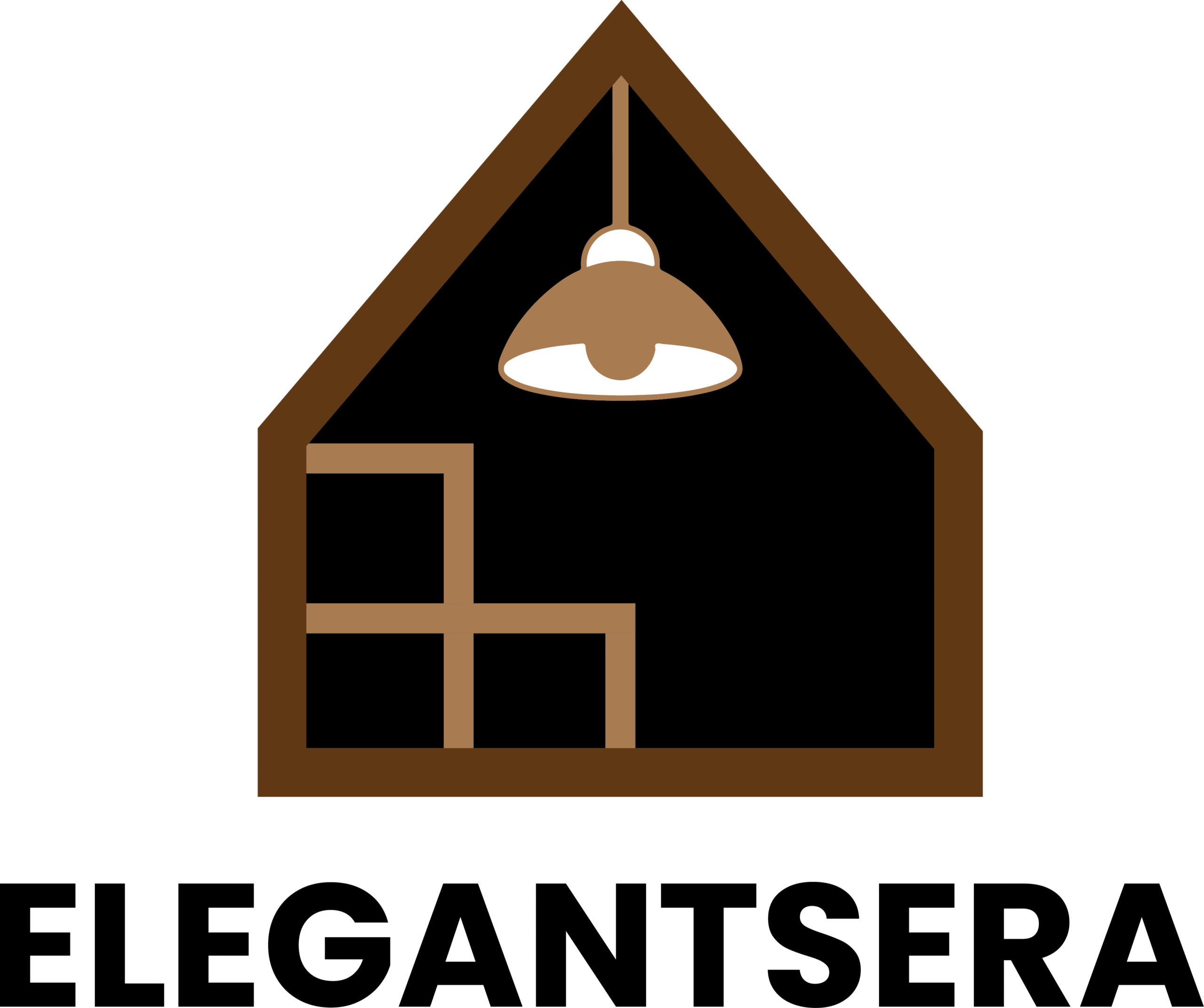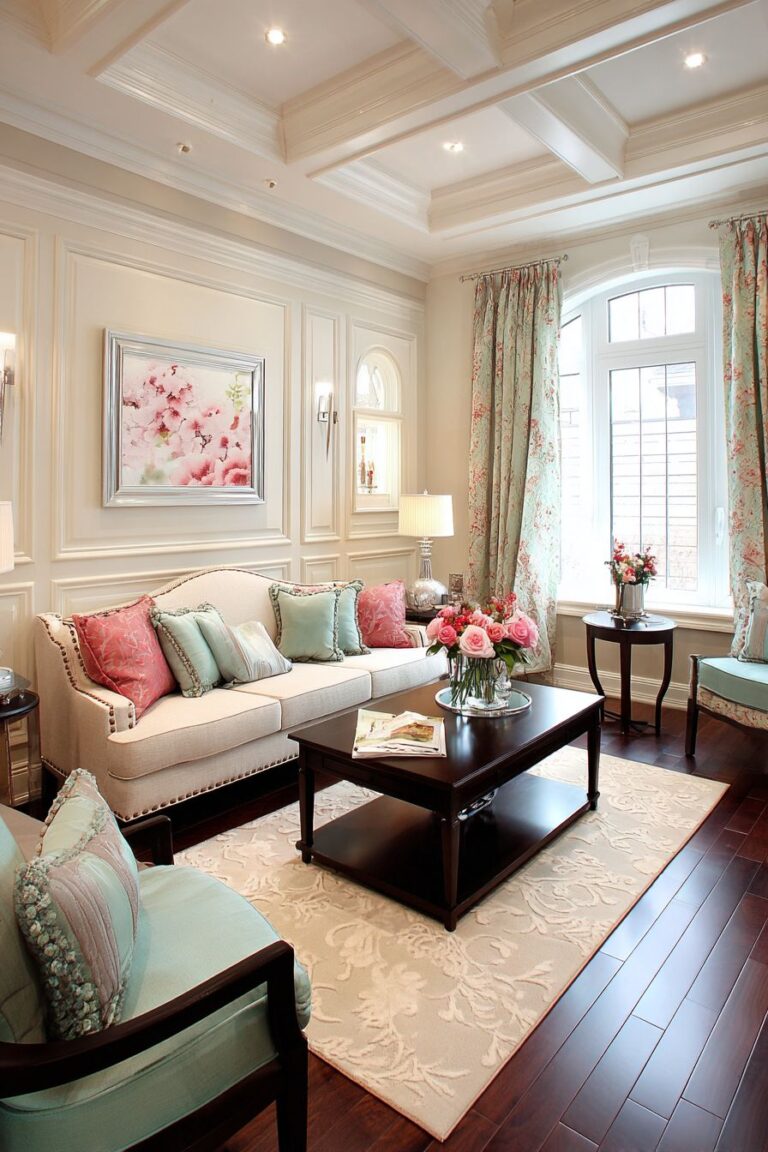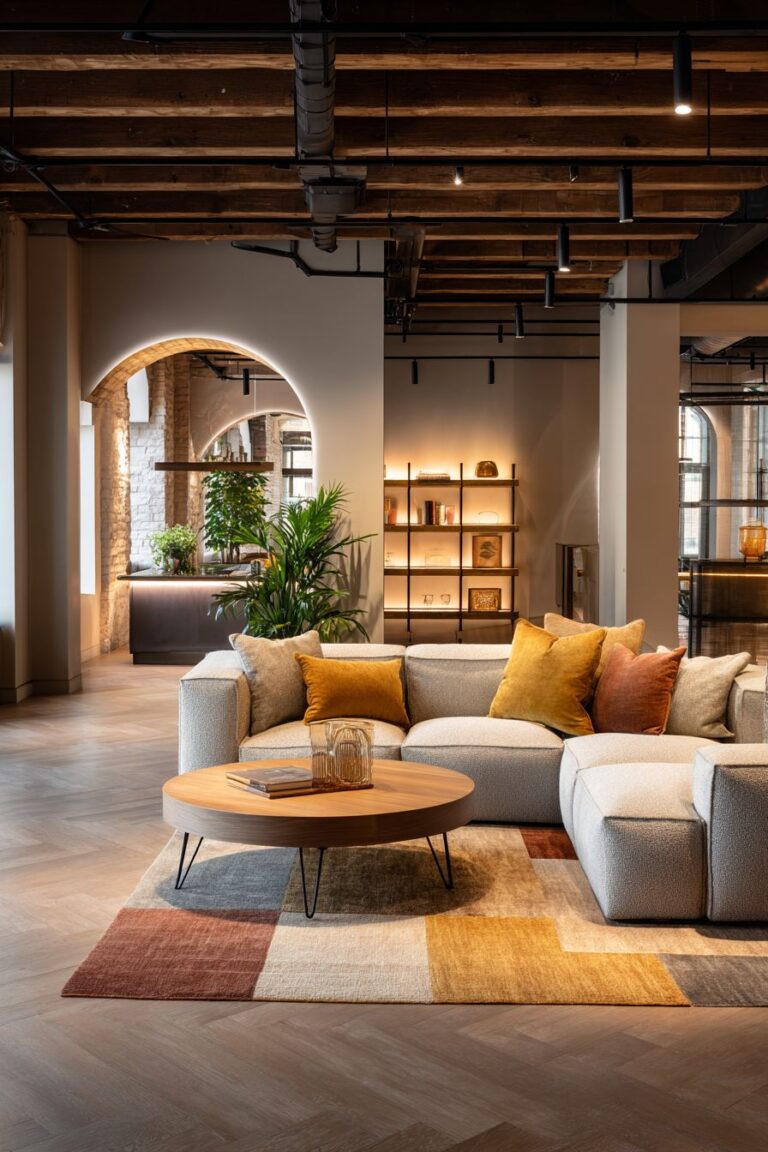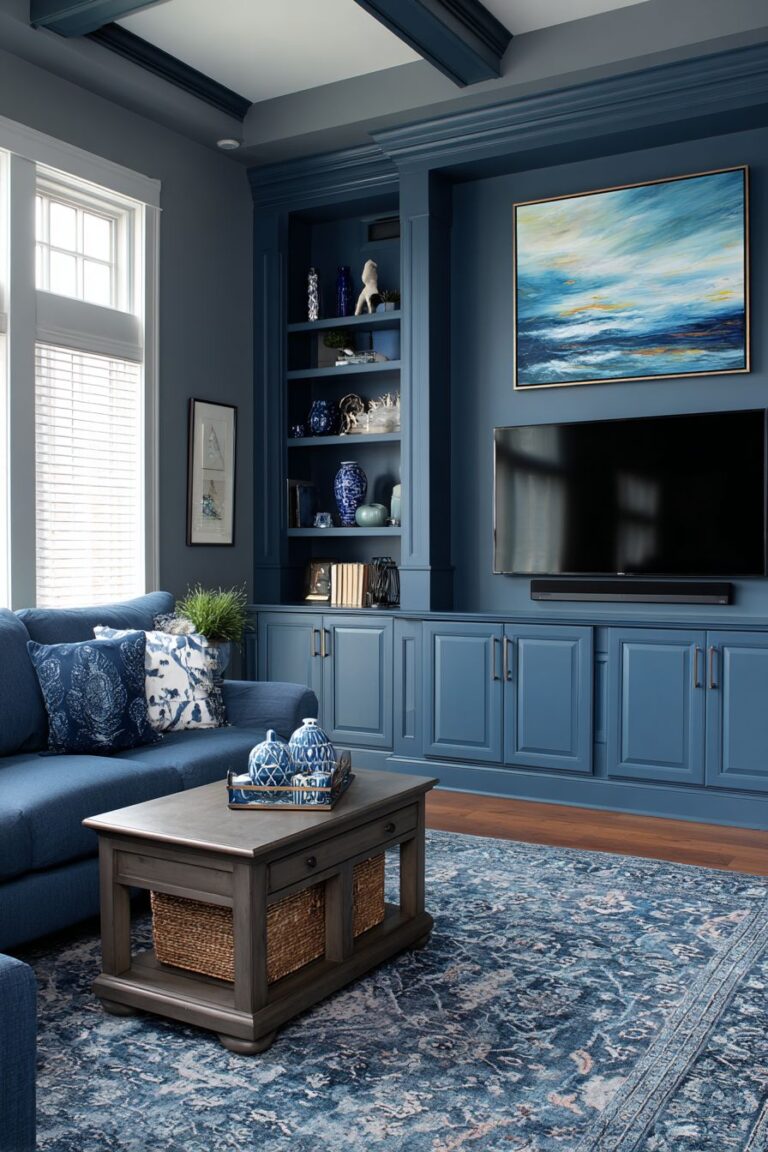20 Inspiring Midcentury Modern Living Room Ideas: Design for Timeless Style
The midcentury modern aesthetic continues to captivate homeowners and designers decades after its inception, representing a perfect marriage of form and function that feels as fresh today as it did in the 1950s and 60s. This distinctive design movement, characterized by clean lines, natural materials, and an emphasis on bringing the outdoors in, offers a timeless approach to interior design that transcends fleeting trends. Thoughtful interior design has the power to transform not just the appearance of a space, but the entire experience of living within it, creating environments that inspire, comfort, and energize us daily.
The beauty of midcentury modern design lies in its versatility and accessibility. Whether you’re drawn to the warm wood tones of Danish modern furniture, the bold geometric patterns of period textiles, or the seamless indoor-outdoor living that defined the era, this style offers something for every personality and lifestyle. From minimalist aesthetics that celebrate negative space to richly textured environments that invite touch and exploration, midcentury modern design proves that simplicity and sophistication can coexist beautifully.
In this comprehensive guide, we’ll explore twenty distinct approaches to creating stunning midcentury modern living rooms, each offering unique insights into materials, color palettes, furniture selection, and spatial arrangements. These design concepts showcase the incredible range possible within this beloved aesthetic, from intimate reading nooks to expansive entertainment areas, proving that midcentury modern style can adapt to any space or need while maintaining its essential character and timeless appeal.
1. Rich Cognac Leather and Walnut Warmth

The foundation of exceptional midcentury modern design often begins with the careful selection of materials that speak to both comfort and sophistication. In this stunning living room concept, a low-profile sectional sofa upholstered in rich cognac leather creates an anchor point that immediately draws the eye while promising hours of comfortable lounging. The warm, burnished tones of the leather develop character over time, embodying the midcentury principle that furniture should age gracefully and develop a personal patina through use.
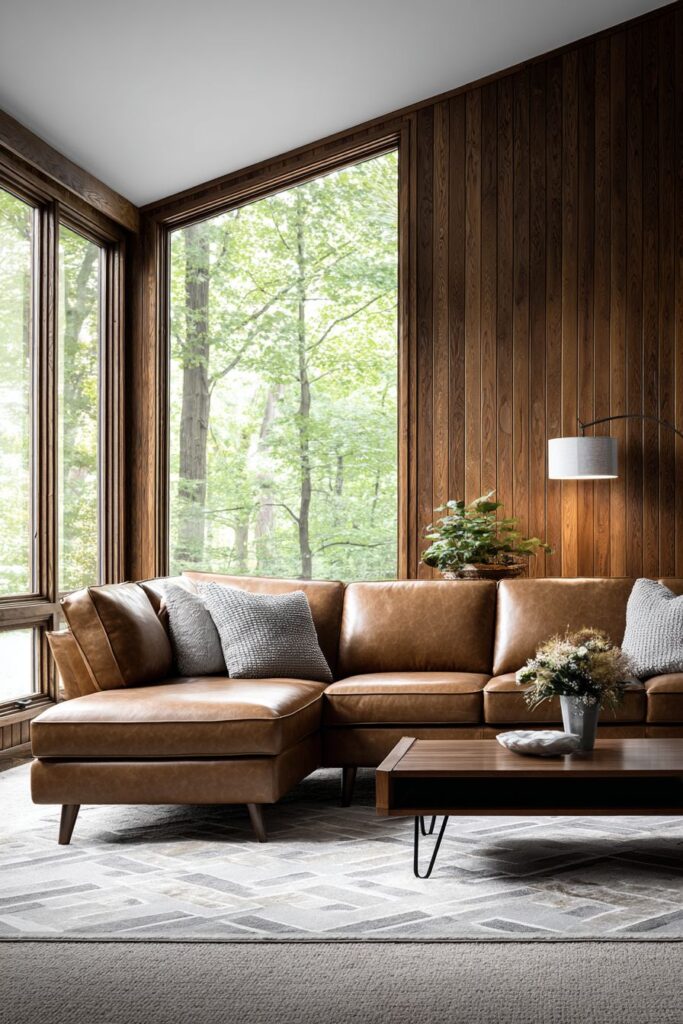
The sleek walnut coffee table with its distinctive hairpin legs represents the era’s obsession with honest construction and visible joinery. These slender metal supports, seemingly defiant of gravity, showcase the period’s confidence in new materials and manufacturing techniques while creating visual lightness that prevents the substantial leather seating from overwhelming the space. The interplay between the organic curves of the sectional and the geometric precision of the table legs creates a dynamic tension that keeps the eye engaged.
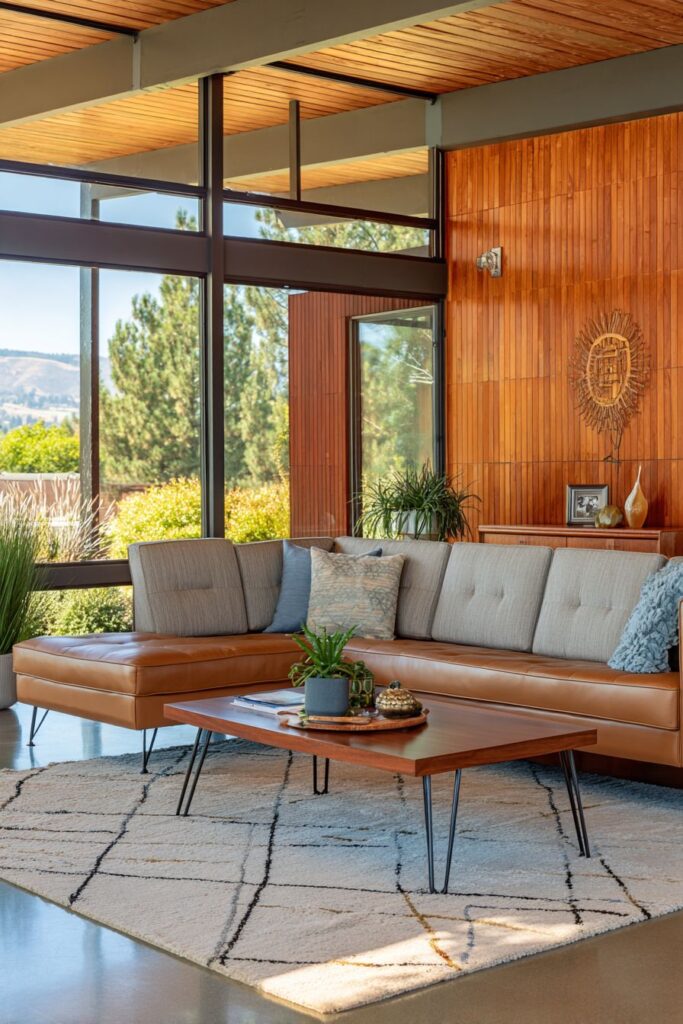
The room’s defining feature—a wall of warm teak paneling—serves as both a textural element and a dramatic backdrop that grounds the entire composition. This wood treatment, with its distinctive grain patterns and honey-colored patina, reflects the midcentury fascination with bringing natural materials indoors in their most honest form. The paneling creates depth and warmth while serving as a perfect counterpoint to the expansive floor-to-ceiling windows that flood the space with natural light, establishing the indoor-outdoor connection so fundamental to the movement.
The geometric area rug in muted earth tones provides the final layer that ties the composition together, its abstract patterns echoing the mathematical precision beloved by midcentury designers while its natural fiber construction reinforces the connection to organic materials. The rug’s scale and placement define the conversation area while providing acoustic softening in a space dominated by hard surfaces.
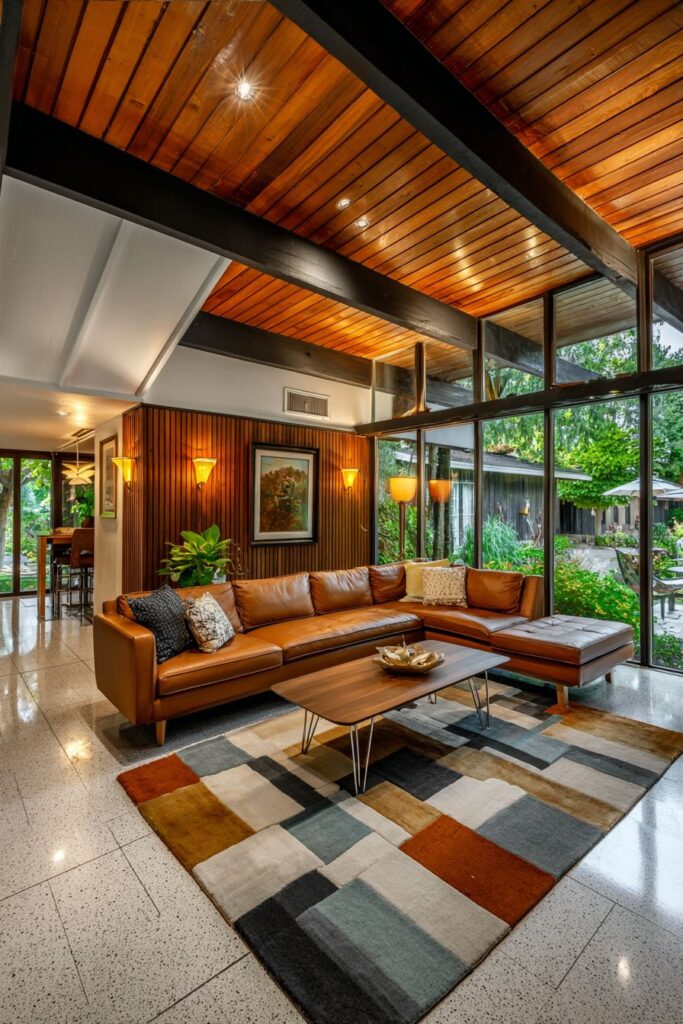
Key Design Tips:
- Choose leather furniture in rich, warm tones that will develop character over time
- Incorporate hairpin leg furniture to achieve the signature midcentury lightweight aesthetic
- Use natural wood paneling as an accent wall to add warmth and texture
- Position large area rugs to define conversation areas and add visual weight to furniture groupings
- Maximize natural light with unadorned large windows to emphasize the indoor-outdoor connection
2. Iconic Eames Design and Natural Light
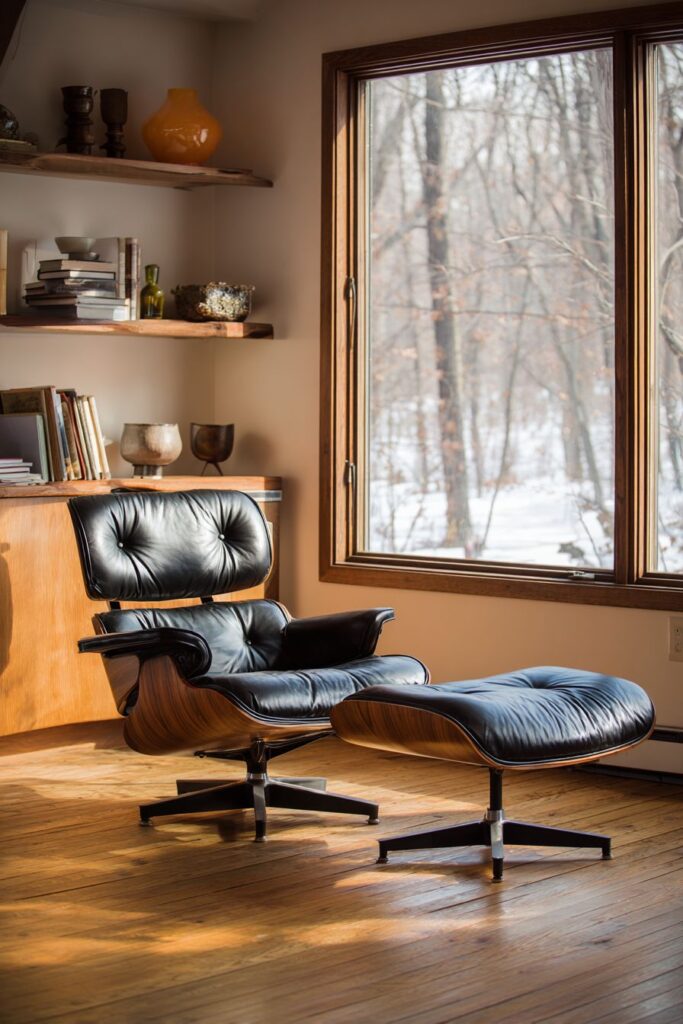
The Eames lounge chair and ottoman stand as perhaps the most recognizable symbols of midcentury modern design, and their presence in any living room immediately establishes both aesthetic intent and design pedigree. In this thoughtfully composed space, the classic pairing of black leather upholstery with the warm walnut wood frame creates a study in contrasts that exemplifies the era’s sophisticated approach to material selection. The chair’s sculptural form, with its curved plywood shells and careful proportions, represents the marriage of comfort and artistic expression that defined the best of midcentury furniture design.
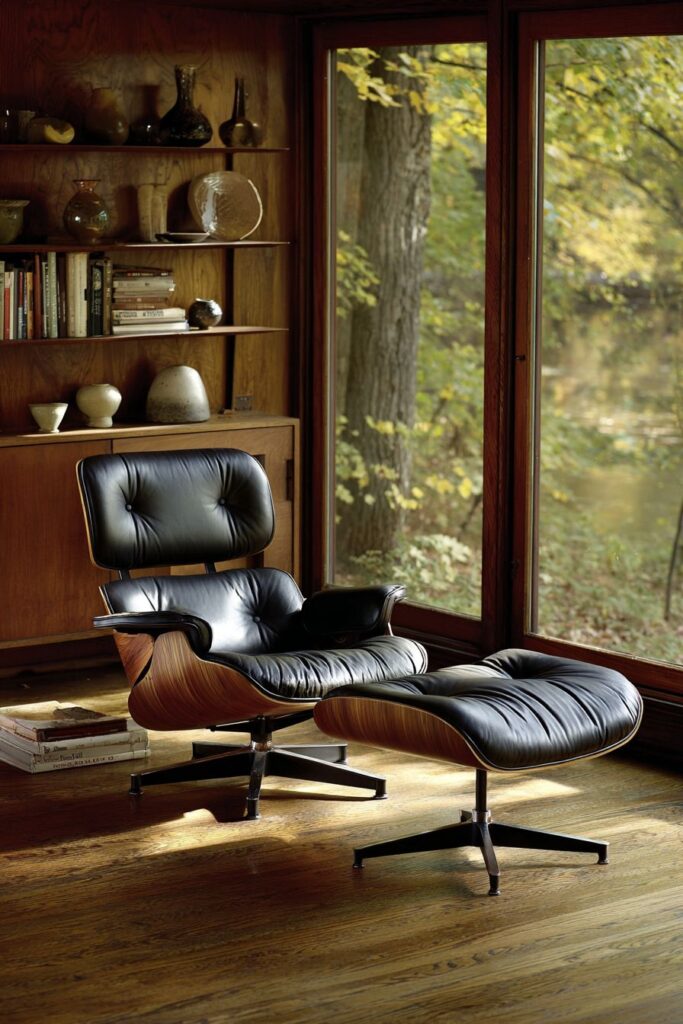
The strategic placement near a large picture window transforms this iconic seating into more than just furniture—it becomes a destination within the room, a place for contemplation and connection with the outdoor environment. The unadorned window treatment allows natural light to stream across the leather surfaces, highlighting the subtle grain of the wood frame while creating the kind of dramatic interplay between light and shadow that midcentury architects celebrated in their residential designs.
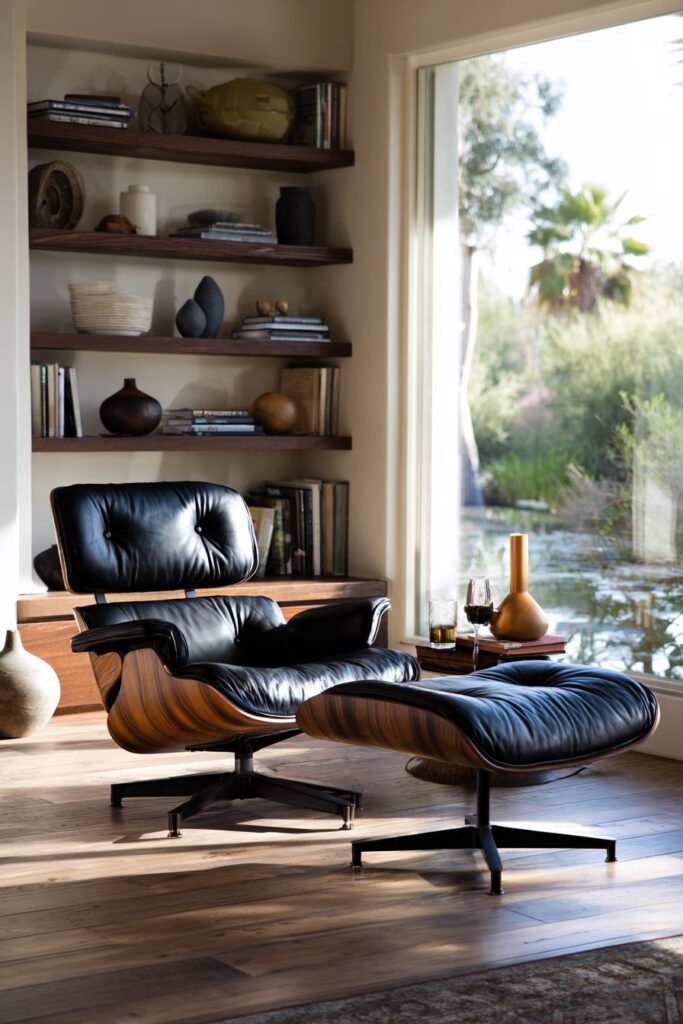
Built-in floating shelves demonstrate the period’s commitment to clean lines and integrated storage solutions. Rather than relying on bulky bookcases or entertainment centers, these streamlined shelves appear to float against the wall, their minimal profiles allowing the objects they display to take center stage. The careful curation of ceramic pottery and vintage books creates vignettes that feel both personal and museum-quality, reflecting the midcentury belief that everyday objects could possess both functional and artistic value.
The natural oak flooring, with its prominent grain patterns and honest finish, provides a foundation that celebrates the beauty of wood in its most authentic form. The flooring’s warm tones and organic patterns create visual movement throughout the space while providing the kind of durable, natural surface that improves with age—a core principle of sustainable midcentury design philosophy.
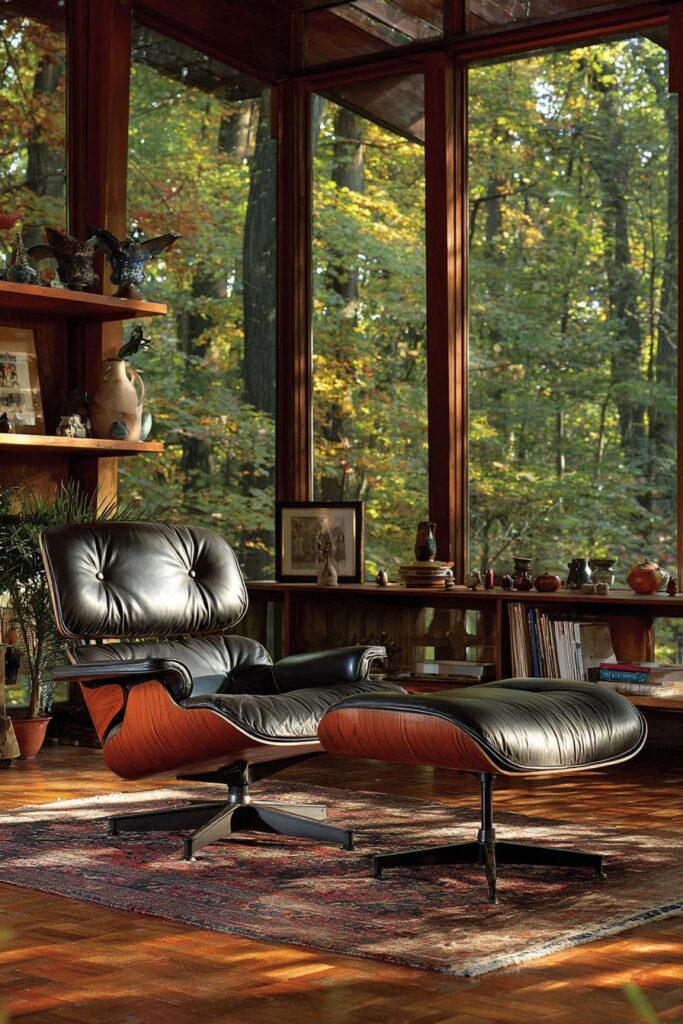
Key Design Tips:
- Invest in authentic or high-quality reproduction pieces from iconic midcentury designers
- Position statement furniture near windows to create dramatic lighting effects
- Use built-in or floating shelves to maintain clean lines while providing display opportunities
- Choose wide-plank hardwood flooring with prominent grain patterns for authentic period character
- Create curated display arrangements with a mix of functional and decorative objects
3. Dramatic Starburst Lighting and Geometric Forms

The starburst chandelier serves as the dramatic focal point in this sophisticated living room, its radiating arms and multiple light sources creating both illumination and sculpture suspended in space. This iconic lighting form, with its atomic-age optimism and mathematical precision, perfectly captures the midcentury fascination with both scientific discovery and artistic expression. When properly scaled and positioned, a starburst fixture transforms an ordinary ceiling into a gallery-worthy installation while providing the kind of ambient lighting that makes evening entertaining feel magical.
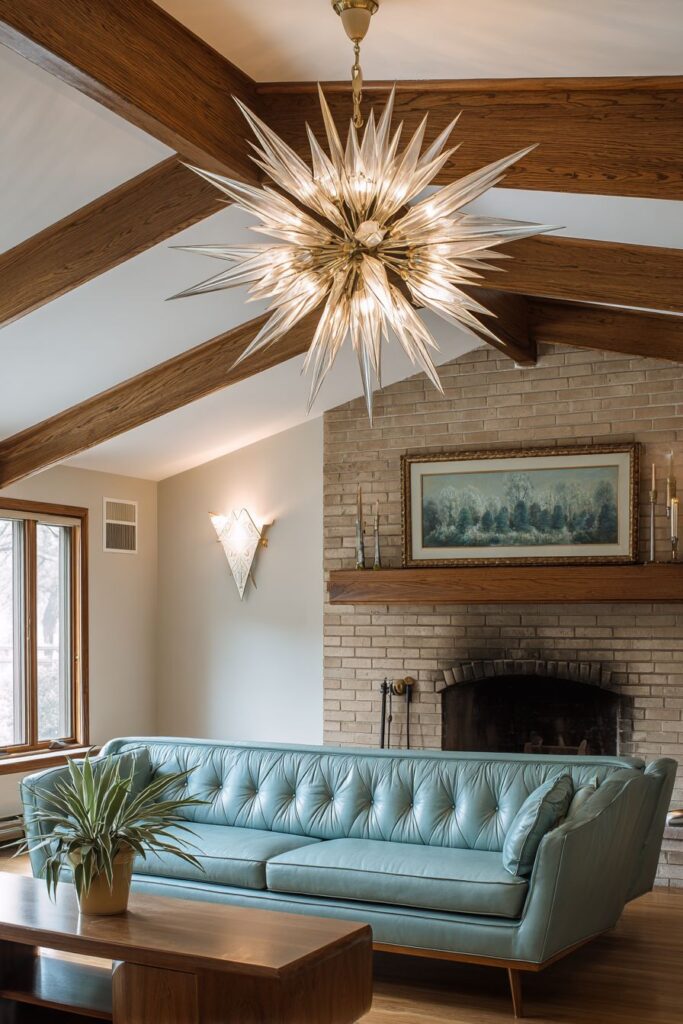
The conversation area below features a low tufted sofa in sage green fabric, a color choice that reflects the era’s embrace of nature-inspired hues that felt both sophisticated and calming. The sage green provides a perfect complement to the warm wood tones throughout the space while maintaining the kind of understated elegance that prevents any single element from overwhelming the composition. The sofa’s low profile and clean lines echo the horizontal emphasis that defined residential architecture of the period.
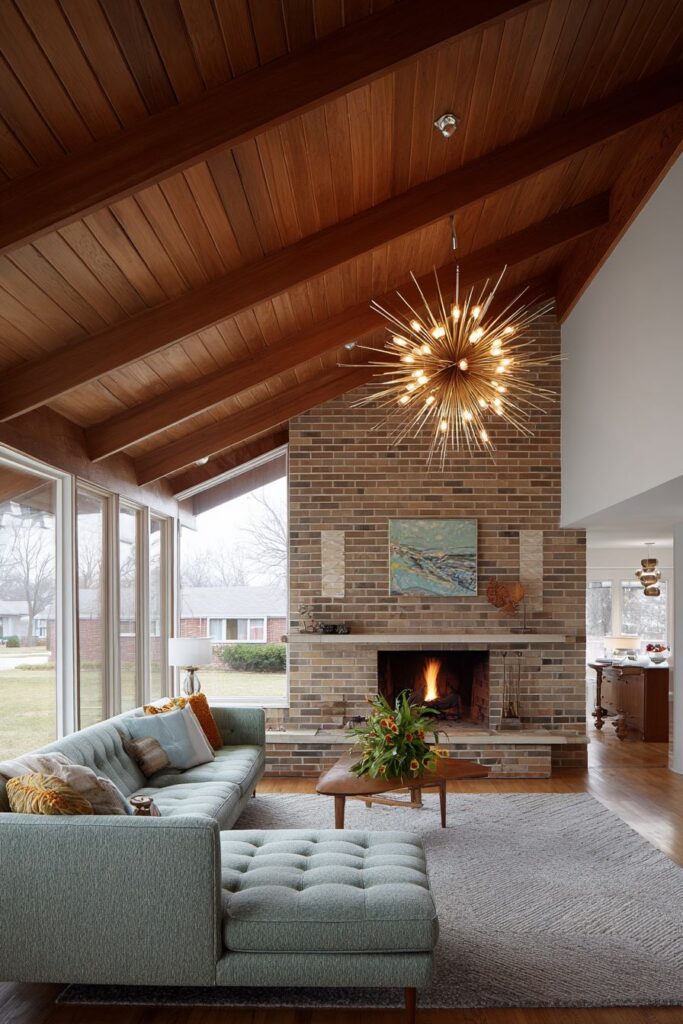
The brick fireplace with its clean geometric lines and floating hearth represents the midcentury approach to traditional elements—maintaining their essential function while stripping away unnecessary ornamentation. The fireplace becomes a sculptural element in its own right, its materiality and form creating visual weight that anchors the seating arrangement while providing the kind of gathering point that makes a living room truly livable.
Warm wood ceiling beams add architectural interest and help define the scale of the room, their horizontal lines reinforcing the period’s emphasis on connection to the landscape beyond. These structural elements, left exposed and celebrated rather than hidden, reflect the midcentury principle of honest construction where the building’s bones become part of its aesthetic appeal.

Key Design Tips:
- Choose lighting fixtures that serve as sculptural elements as well as functional illumination
- Select furniture in nature-inspired colors that complement rather than compete with natural materials
- Incorporate geometric fireplaces with clean lines and minimal ornamentation
- Use exposed structural elements like ceiling beams to add architectural character
- Create conversation areas with low-profile seating that emphasizes horizontal lines
4. Entertainment and Storage Integration

The sleek walnut credenza in this entertainment-focused living room demonstrates the midcentury mastery of combining beauty with practicality, serving multiple functions while maintaining the clean lines that define the aesthetic. As a TV stand, it provides the perfect scale and proportion for modern flat-screen displays, while its generous storage capacity houses both vintage audio equipment and contemporary electronics with equal grace. The credenza’s distinctive tapered legs and grain-matched wood surfaces showcase the period’s commitment to craftsmanship and material honesty.

The display of vintage audio equipment transforms functional objects into decorative elements, reflecting the midcentury belief that well-designed products deserved to be seen rather than hidden away. Turntables, receivers, and speakers from the era possess the kind of sculptural quality that makes them worthy of display, their brushed metal surfaces and geometric forms contributing to rather than detracting from the room’s overall aesthetic coherence.

Abstract artwork in earth tones hangs above the credenza, creating a gallery wall that feels both curated and personal. The artwork’s warm color palette of ochre, sienna, and burnt orange reflects the optimistic color sensibilities of the era while providing visual interest that draws the eye upward, creating vertical movement in a composition dominated by horizontal elements.
The boomerang-shaped coffee table represents the period’s fascination with organic forms and atomic-age symbolism, its curved profile contrasting beautifully with the geometric precision of the credenza and seating. This sculptural table sits atop a textured wool rug with geometric patterns, adding another layer of visual interest while providing the kind of tactile contrast that makes a space feel rich and inviting.
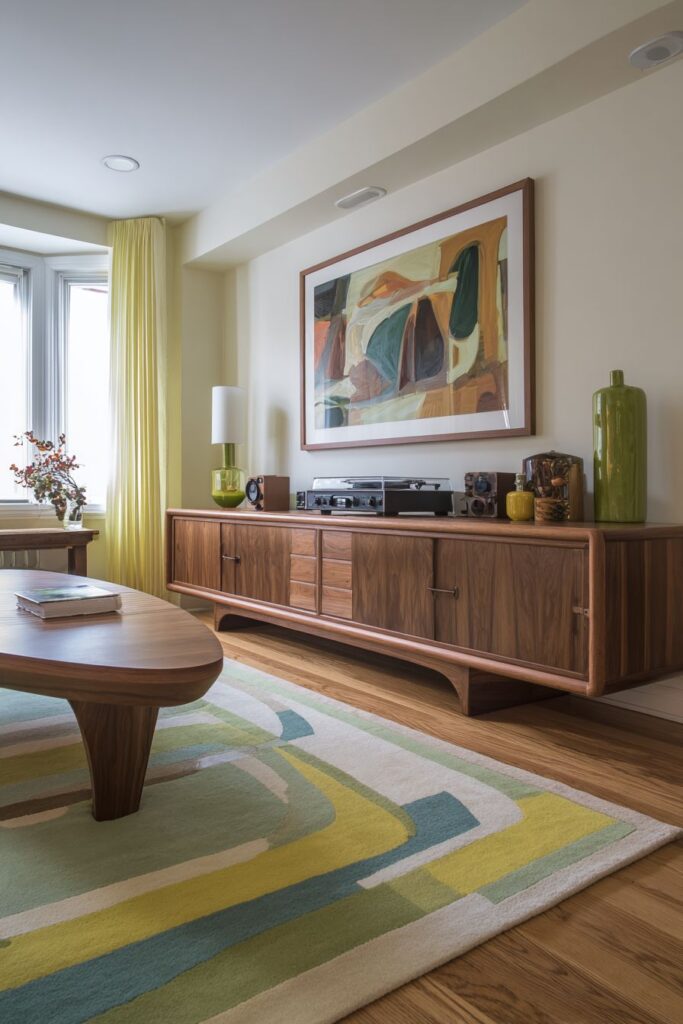
Key Design Tips:
- Choose storage furniture that displays beautiful objects rather than hiding them
- Incorporate vintage audio equipment as decorative elements
- Select artwork in warm earth tones that complement natural wood finishes
- Use sculptural coffee tables with organic forms to balance geometric furniture
- Layer geometric patterns in rugs and textiles for visual richness
5. Built-in Storage and Seamless Integration
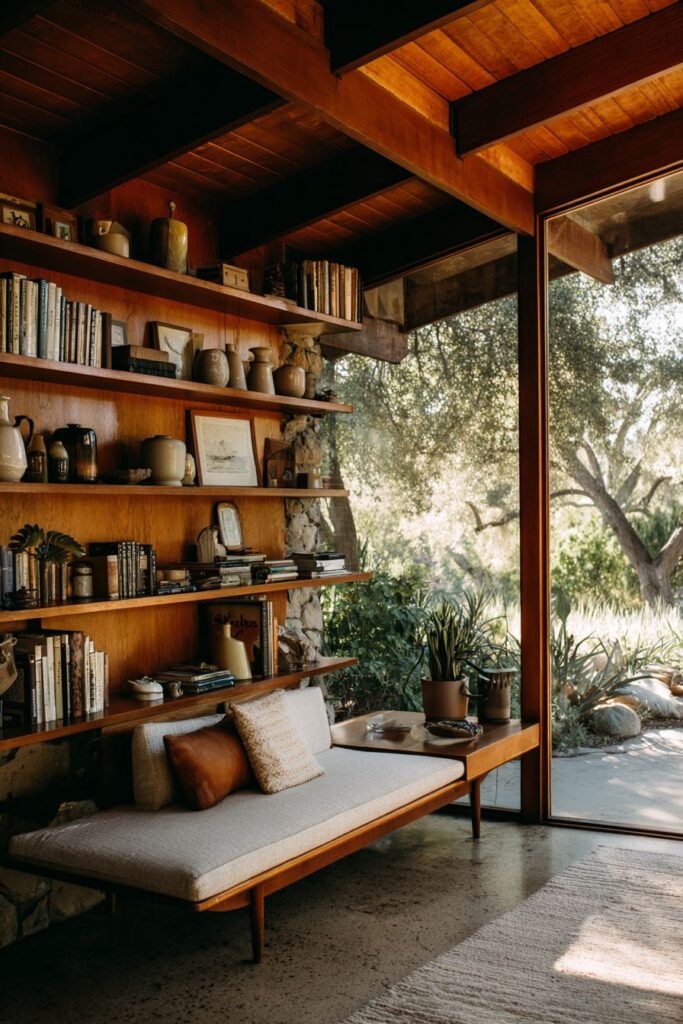
Floor-to-ceiling built-in shelving in warm walnut wood demonstrates the midcentury commitment to integrating storage solutions seamlessly into the architecture of the room. These custom shelving units, with their clean lines and honest construction, eliminate the visual clutter of freestanding furniture while creating opportunities for displaying the kind of carefully curated collections that define sophisticated living spaces. The shelves’ warm wood tones and visible grain patterns maintain material consistency throughout the room while providing infinite possibilities for personal expression through displayed objects.
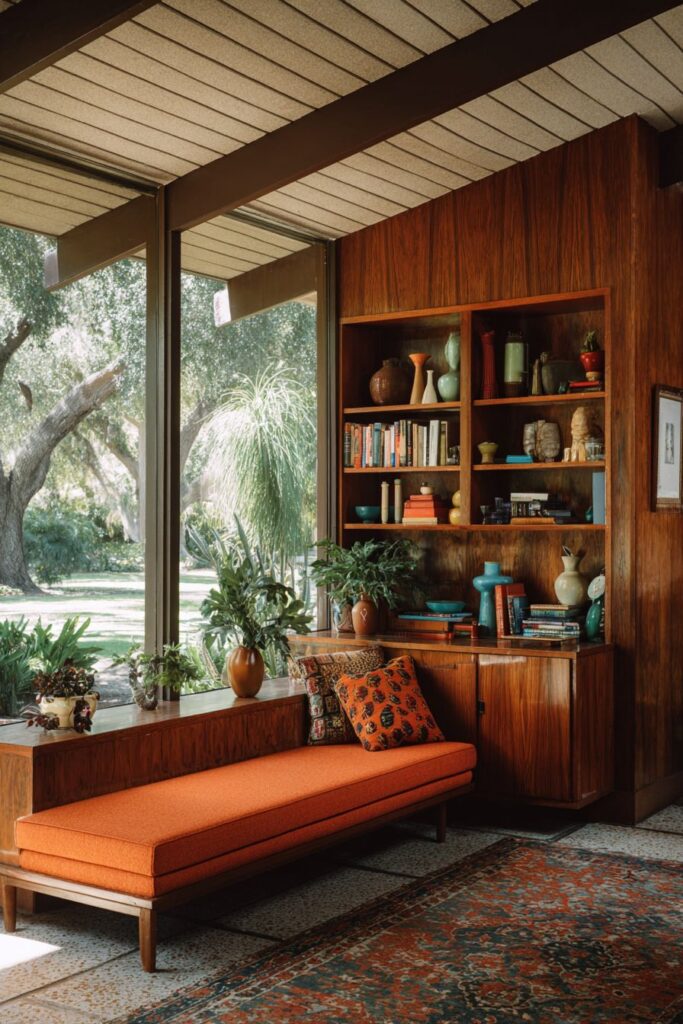
The Nelson platform bench positioned beneath the window serves multiple functions while maintaining the sleek profile that characterizes period furniture design. As additional seating for entertaining or as a display surface for books and decorative objects, the bench exemplifies the midcentury principle that every piece of furniture should serve multiple purposes without sacrificing aesthetic appeal. Its slat construction and minimal profile allow natural light to filter through while creating interesting shadow patterns on the floor.
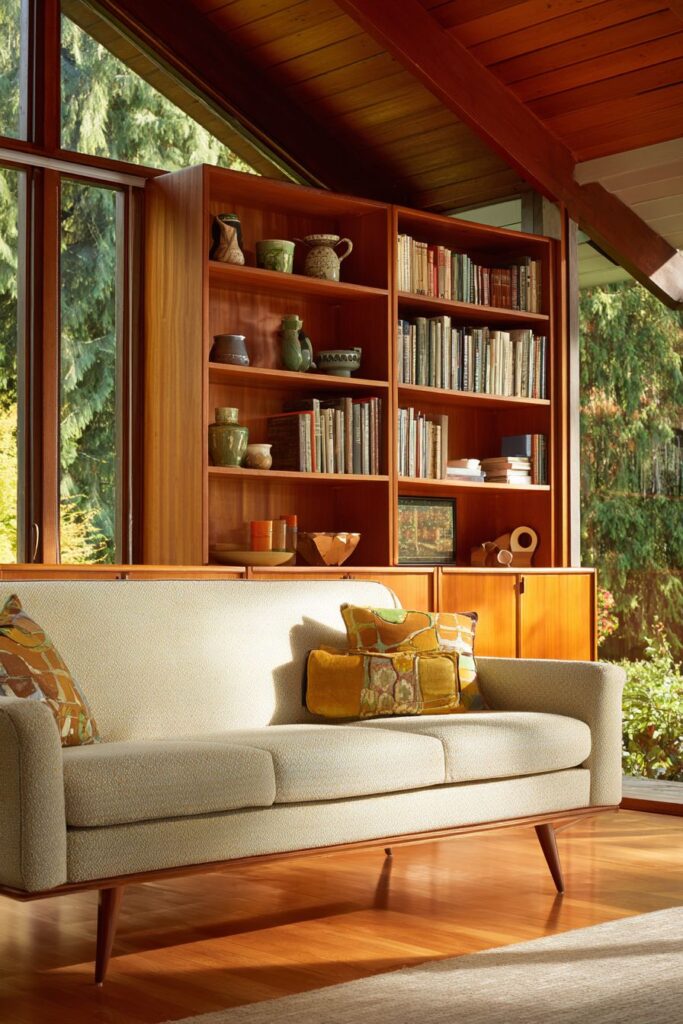
The low-profile sofa with tapered wooden legs and clean upholstery lines anchors the seating area while demonstrating the period’s mastery of proportion and scale. The sofa’s horizontal emphasis and minimal ornamentation allow the room’s architectural elements and curated displays to take center stage, while its comfortable proportions ensure that the space remains as livable as it is beautiful.
The seamless integration of storage and style reflects the midcentury belief that good design should enhance daily life rather than complicate it. Every element serves a purpose, from the display of books and ceramics to the provision of additional seating, creating a living space that functions as smoothly as it appears.
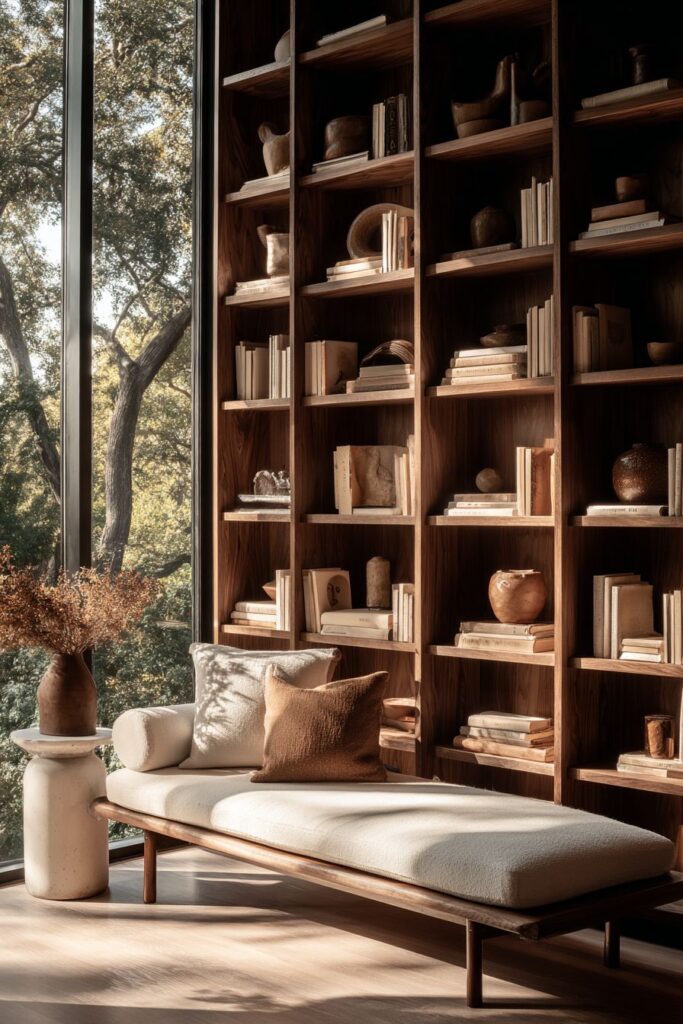
Key Design Tips:
- Design built-in storage to match existing architectural elements for seamless integration
- Use platform benches for flexible seating that doesn’t overwhelm small spaces
- Choose sofas with exposed wooden legs to maintain visual lightness
- Display curated collections of books and ceramics for personal expression
- Prioritize multi-functional furniture that serves multiple purposes
6. Natural Stone and Metal Contrasts
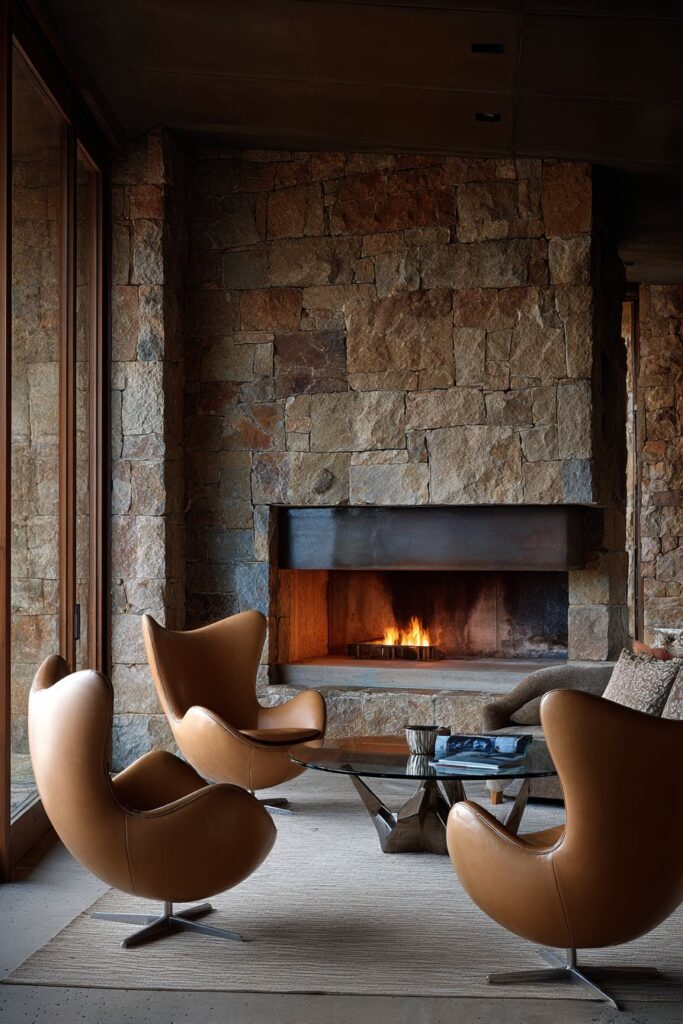
The dramatic stone fireplace wall featuring natural fieldstone in varying earth tones creates a powerful focal point that celebrates the raw beauty of natural materials. This substantial element, with its organic textures and color variations, provides the kind of visual weight and tactile interest that grounds the entire living space while connecting it to the natural world beyond. The fieldstone’s irregular patterns and weathered surfaces contrast beautifully with the refined modern furniture, creating the kind of material dialogue that defines sophisticated midcentury interiors.
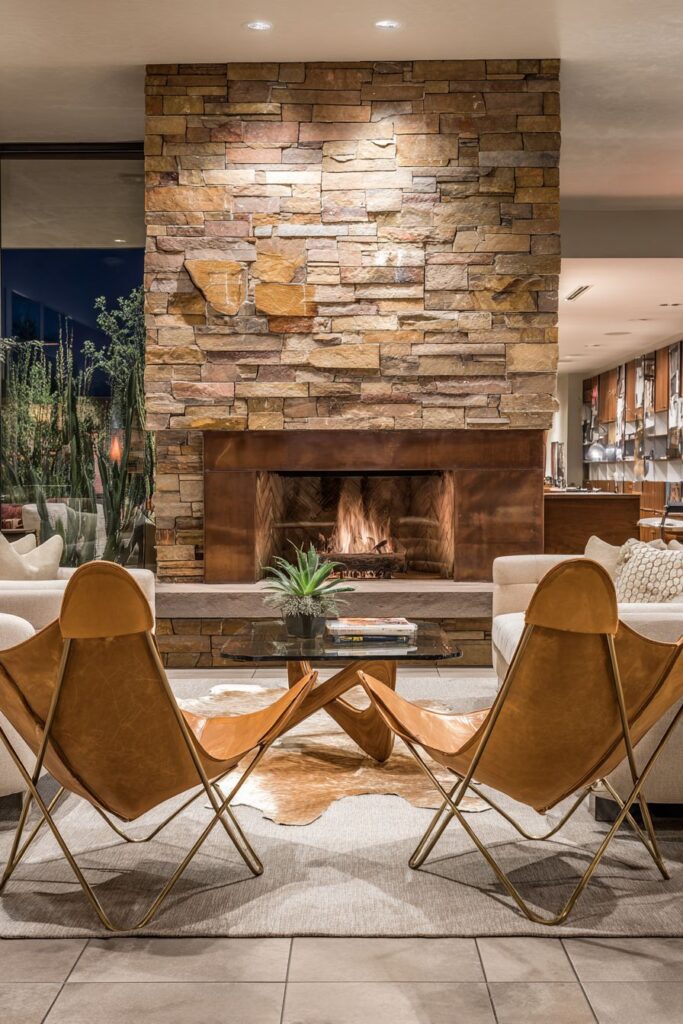
The sleek metal firebox, with its clean lines and precise geometry, represents the perfect marriage of traditional hearth function with modern aesthetic sensibilities. This contemporary element nestled within the rustic stone surround demonstrates the midcentury mastery of combining seemingly contradictory materials to create harmony rather than conflict. The metal’s reflective surfaces and sharp edges provide the perfect counterpoint to the stone’s organic irregularity.
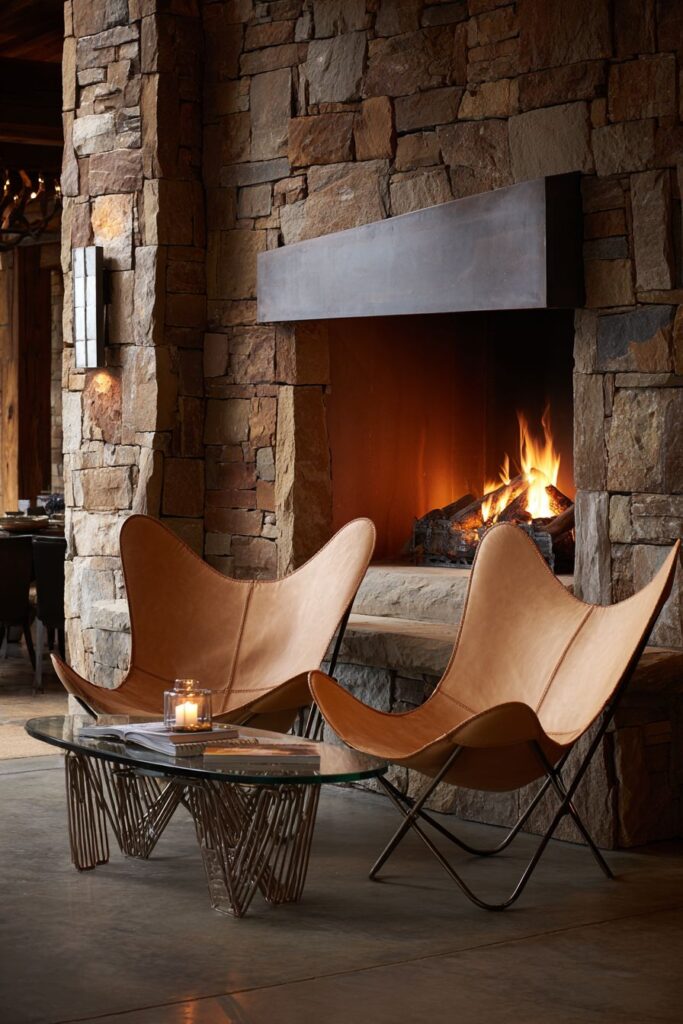
Butterfly chairs in tan leather flank the hearth, their sculptural forms and industrial materials embodying the period’s fascination with new manufacturing techniques and material innovations. These iconic chairs, with their canvas or leather seats suspended between metal frames, represent the democratic design ideals of the era—beautiful, functional furniture that could be mass-produced without sacrificing aesthetic integrity.
The glass-top coffee table with its sculptural metal base continues the theme of material innovation, its transparent surface maintaining visual lightness while the metal base provides sculptural interest. This combination of glass and metal reflects the period’s optimistic embrace of industrial materials in residential settings, transforming utilitarian elements into objects of beauty.
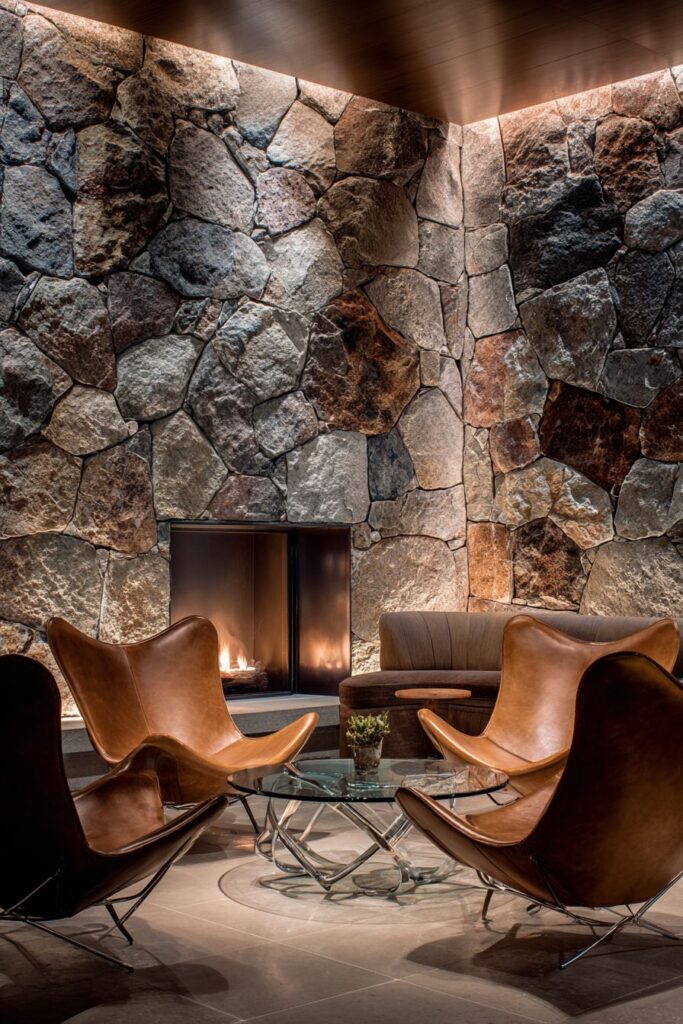
Key Design Tips:
- Use natural stone as a dramatic accent wall to add texture and visual weight
- Contrast organic materials with sleek metal elements for dynamic visual interest
- Incorporate iconic furniture pieces like butterfly chairs for authentic period character
- Choose glass-top tables to maintain visual lightness in furniture-heavy rooms
- Balance rustic and refined materials for sophisticated material dialogue
7. Indoor-Outdoor Living and Transparency
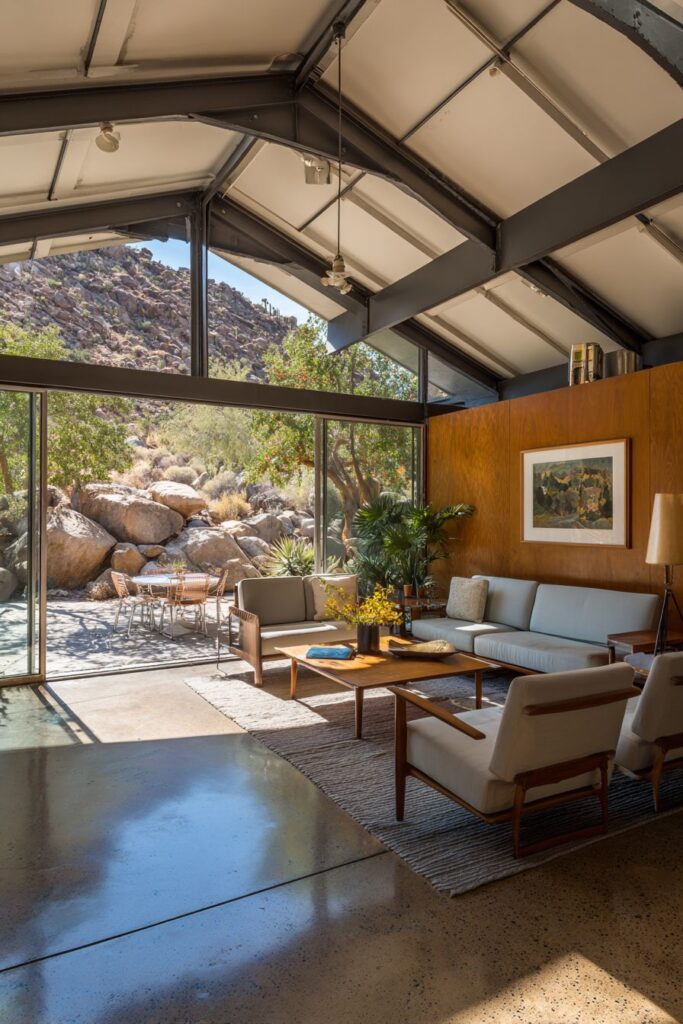
The expansive sliding glass doors in this living room create the seamless indoor-outdoor connection that defined midcentury residential design, literally erasing the boundaries between interior and exterior spaces. These floor-to-ceiling glass panels, with their minimal frames and smooth operation, represent the technological achievements and optimistic world view of the era, where the home was conceived as a pavilion within the landscape rather than a fortress against it.

The modular seating arrangement in neutral linen faces the outdoor view, its flexible configuration allowing for various social arrangements while maintaining focus on the connection to the exterior. The choice of natural linen upholstery reflects the period’s preference for honest, breathable materials that age gracefully while providing the kind of casual comfort that encourages relaxation and informal entertaining.
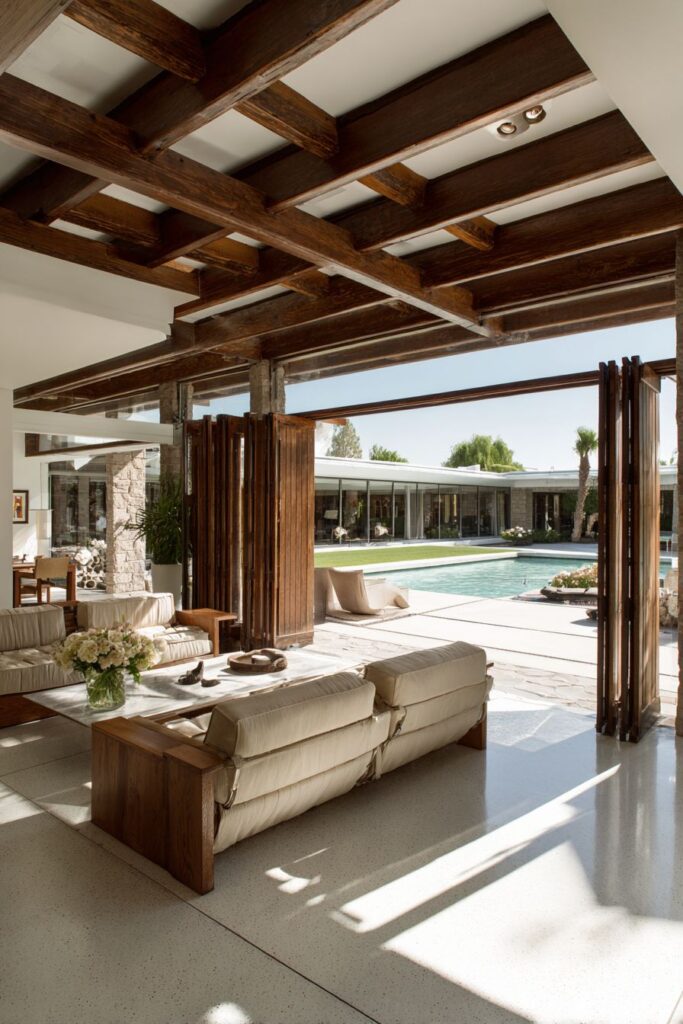
Polished concrete floors extend throughout the interior, their industrial origin transformed into residential elegance through expert finishing and careful integration with the overall design scheme. The concrete’s thermal mass helps moderate interior temperatures while its seamless surface creates visual continuity that enhances the sense of expansive space. The material’s subtle variations in tone and texture provide interest without competing with the dramatic outdoor views.
Exposed ceiling beams add structural honesty and architectural character while creating a sense of shelter that balances the room’s openness to the outdoors. These horizontal elements, whether original structural members or decorative additions, reinforce the period’s emphasis on horizontal lines while providing visual weight that prevents the space from feeling too ethereal.
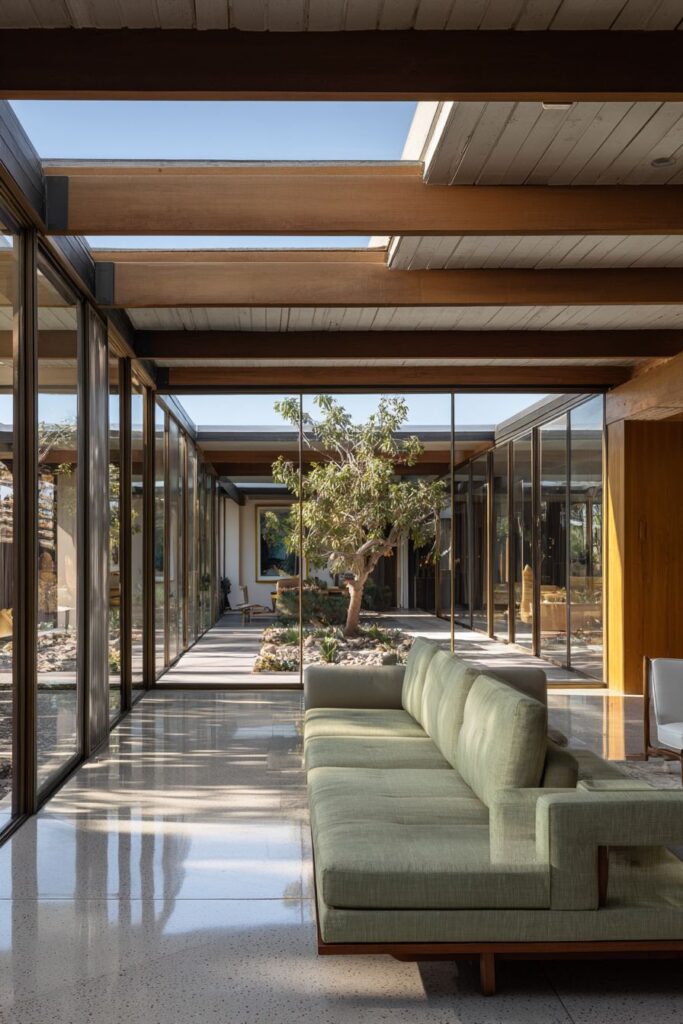
Key Design Tips:
- Install floor-to-ceiling sliding doors to maximize indoor-outdoor connection
- Choose modular seating arrangements that can adapt to different social configurations
- Use polished concrete floors for seamless transitions between interior and exterior
- Incorporate natural fiber upholstery for casual comfort and authentic period character
- Add exposed ceiling beams to create architectural interest and visual weight
8. Terrazzo Flooring and Sunken Conversations

The beautiful terrazzo flooring with its distinctive aggregate patterns represents one of the most characteristic material choices of the midcentury era, combining practical durability with artistic expression through the careful selection and arrangement of marble chips, glass, and other decorative materials. This seamless surface, with its subtle sparkle and organic variations, provides the perfect foundation for midcentury furniture while creating the kind of continuous plane that emphasizes the horizontal emphasis so beloved by period architects and designers.
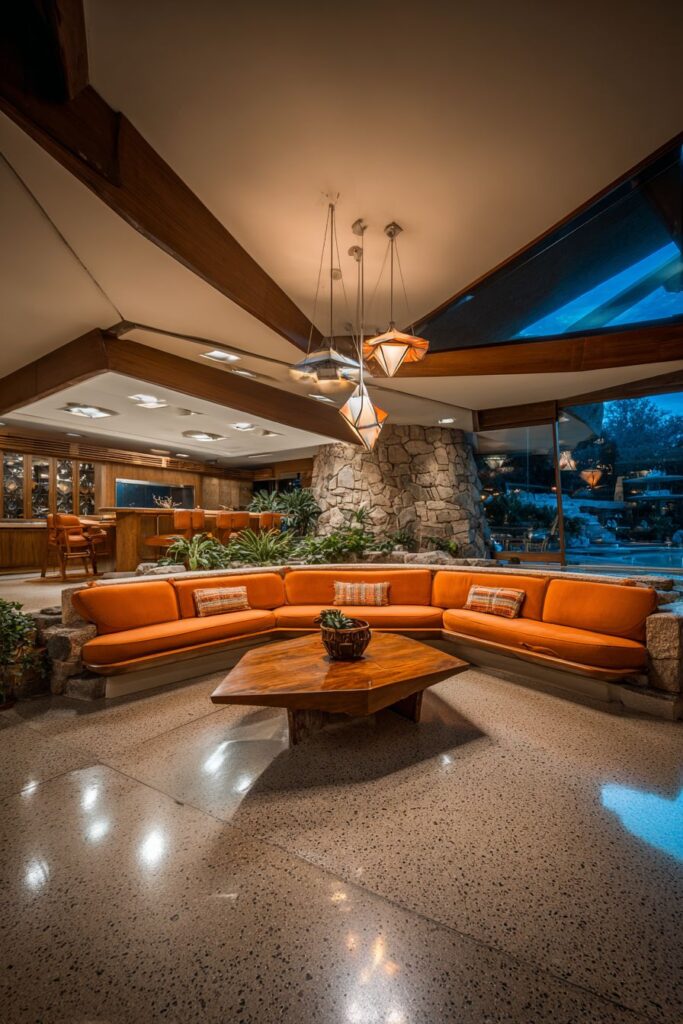
The sunken conversation pit with built-in seating upholstered in warm orange fabric creates an intimate gathering space within the larger room, its lowered floor level and integrated seating fostering the kind of close social interaction that defined midcentury entertaining. This architectural feature, popular in high-end homes of the era, demonstrates the period’s commitment to designing spaces specifically for human interaction and comfort.

The sculptural wooden coffee table positioned at the center of the conversation pit serves as both functional surface and artistic statement, its organic form providing a pleasing contrast to the geometric precision of the built-in seating. The table’s placement and scale create a natural focal point while maintaining the kind of visual accessibility from all seating positions that makes conversation flow naturally.
Pendant lights with geometric shades provide ambient lighting that can be adjusted for different moods and activities, their suspended forms adding vertical interest while their clean-lined shades reinforce the room’s geometric sensibilities. The lighting’s positioning over the conversation area creates an intimate sense of enclosure without compromising the room’s overall sense of spaciousness.

Key Design Tips:
- Consider terrazzo flooring for authentic period character and long-lasting beauty
- Create sunken seating areas for intimate conversation spaces
- Use warm, saturated colors like orange for upholstery to capture period optimism
- Position sculptural coffee tables as focal points in conversation areas
- Install pendant lighting to define different zones within larger open spaces
9. Curated Gallery Walls and Artistic Display
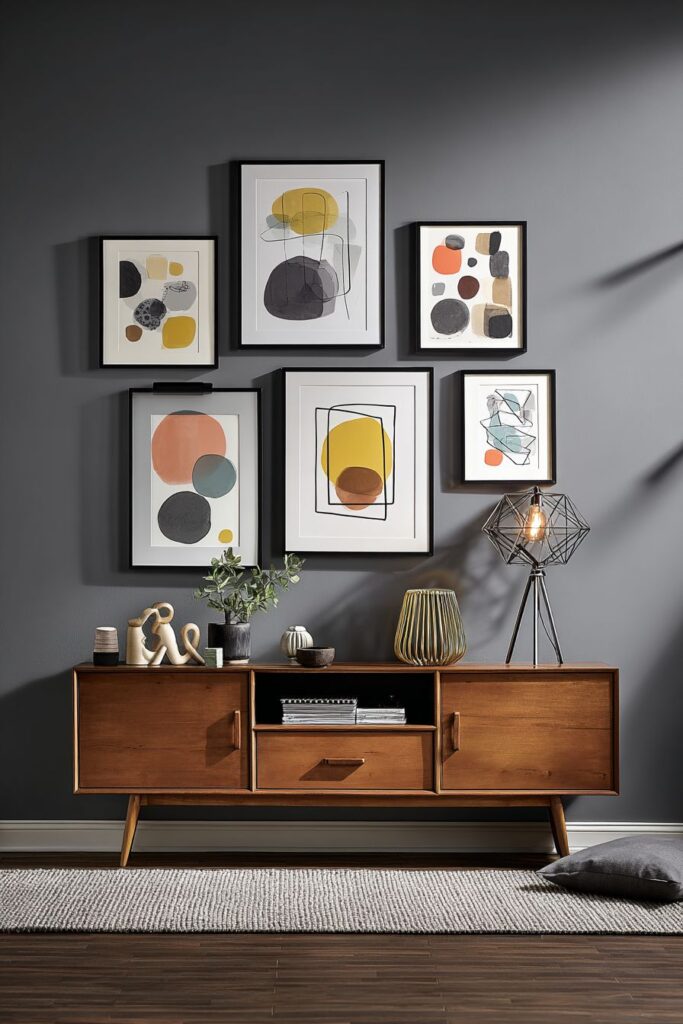
The carefully composed gallery wall in this living room demonstrates the midcentury approach to displaying art, where the arrangement itself becomes a design element as important as the individual pieces. The collection of abstract paintings and prints, housed in frames with thin black profiles, creates a structured grid pattern that reflects the mathematical precision and ordered thinking that characterized the era. This systematic approach to wall display transforms the art from mere decoration into architectural element.
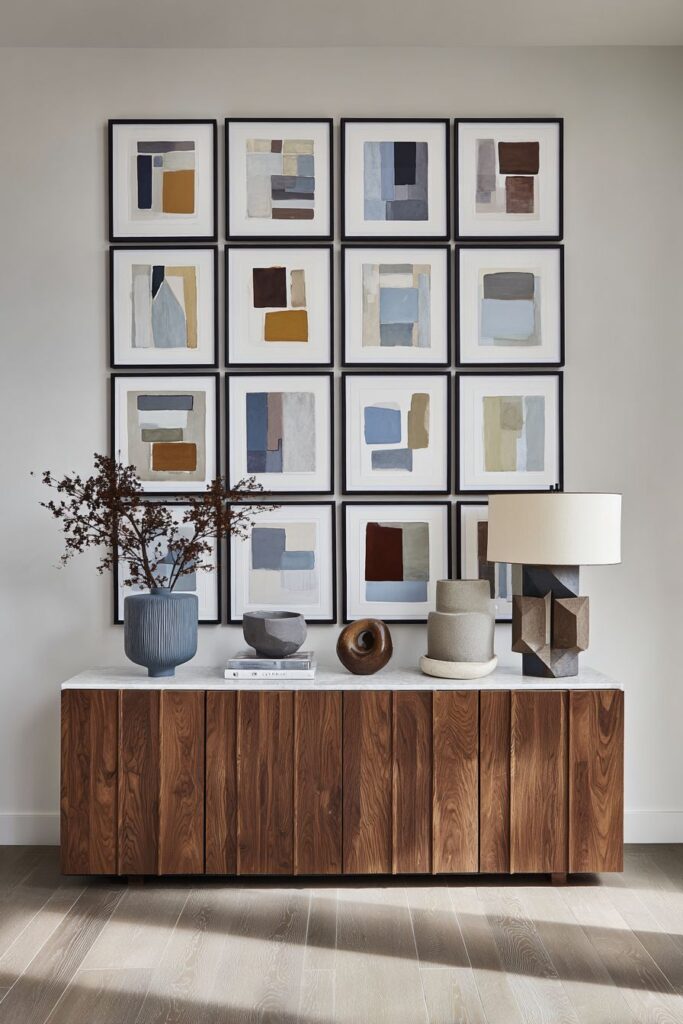
The selection of abstract artwork speaks to the period’s embrace of non-representational art and its optimistic belief in the power of pure form and color to enhance daily life. The paintings’ bold geometric forms and vibrant color palettes provide visual energy while maintaining the sophisticated restraint that prevents them from overwhelming the space. The consistent framing creates unity within diversity, allowing disparate artworks to function as a cohesive whole.
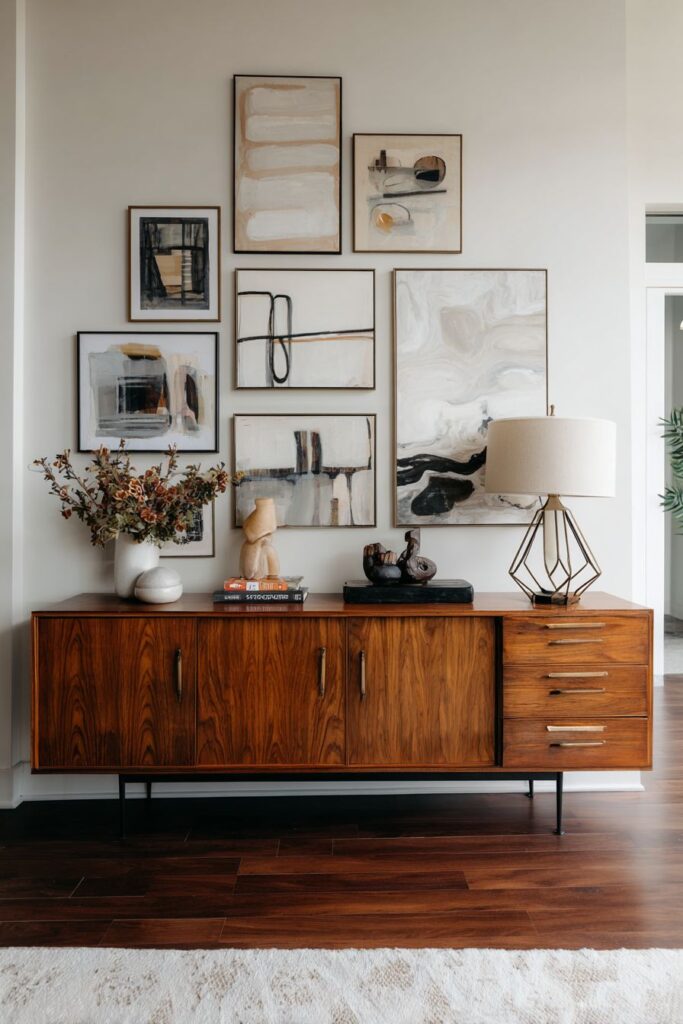
Below the gallery wall, a sleek console table in rich teak wood provides the perfect platform for displaying three-dimensional objects and sculptural lighting. The console’s clean lines and tapered legs maintain visual lightness while offering practical storage and display opportunities. Its warm wood tones create material continuity with other wooden elements throughout the room.
The sculptural objects and vintage lamp displayed on the console demonstrate the midcentury fascination with functional art—objects that serve practical purposes while possessing the formal qualities worthy of aesthetic contemplation. The lamp’s geometric shade and sculptural base exemplify the period’s belief that utilitarian objects could achieve artistic status through thoughtful design.
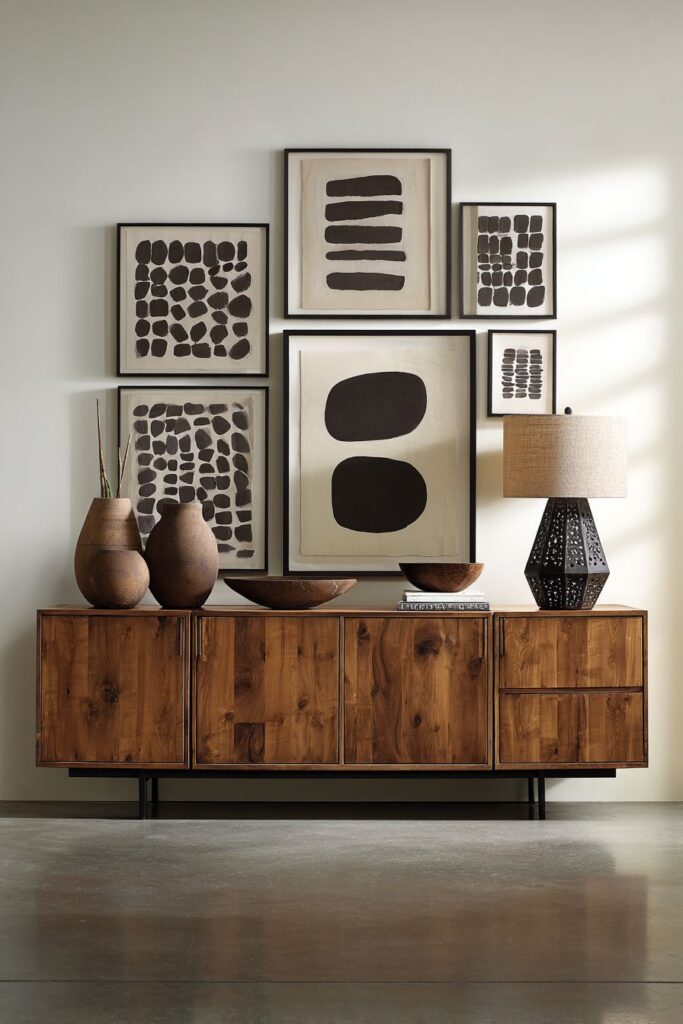
Key Design Tips:
- Create gallery walls with systematic arrangements rather than random clustering
- Choose artwork with bold geometric forms and vibrant colors for period authenticity
- Use consistent framing to unify diverse artworks into coherent compositions
- Display sculptural objects alongside functional items for layered visual interest
- Select lighting with geometric forms that serve as decorative objects when not illuminated
10. Small Space Solutions and Efficient Design

This compact living room demonstrates the midcentury mastery of small space design, proving that limited square footage need not compromise style or functionality. The space-efficient approach begins with careful furniture selection, choosing pieces that maximize utility while maintaining the clean lines and honest materials that define the aesthetic. Every element serves multiple purposes, from storage to seating to display, creating a richly functional environment within minimal square footage.
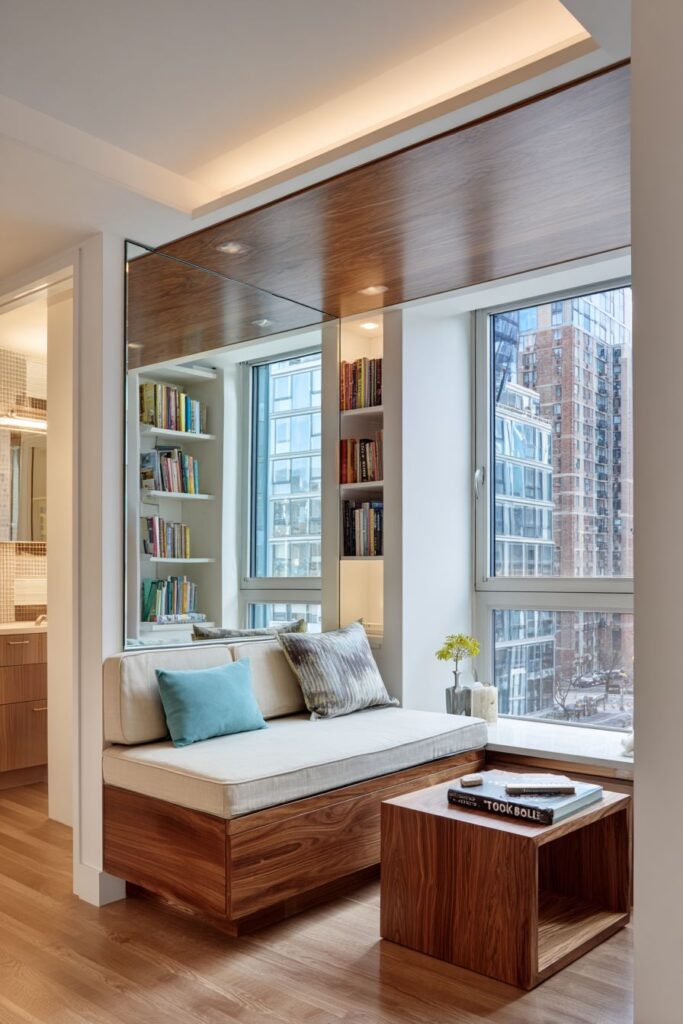
The loveseat with its exposed wooden frame exemplifies the period’s approach to small space furniture—scaled appropriately for intimate spaces while maintaining the structural honesty and material beauty that characterizes the best midcentury design. The exposed frame creates visual lightness that prevents the piece from overwhelming the room while providing the kind of architectural detail that adds sophistication to compact spaces.

The nesting coffee table set in walnut veneer provides flexible surface area that can expand for entertaining or contract for daily living, embodying the adaptive functionality that makes small spaces work efficiently. These tables, with their sculptural forms and rich wood grain, function as artwork when nested together and practical surfaces when separated, demonstrating the period’s genius for multipurpose design.
Built-in corner shelving maximizes vertical storage while maintaining the clean lines essential to successful small space design. These integrated storage solutions eliminate the visual clutter of freestanding furniture while providing display opportunities for books, objects, and plants that personalize the space without overwhelming it.

Key Design Tips:
- Choose furniture scaled appropriately for small spaces without sacrificing style
- Use nesting tables and other multipurpose furniture for flexible functionality
- Install built-in storage solutions to maximize space efficiency
- Position large mirrors strategically to reflect natural light and expand visual space
- Select furniture with exposed frames to maintain visual lightness in compact rooms
11. Classic Color Harmony and Danish Modern

The sophisticated color palette of warm woods, creamy whites, and strategic pops of turquoise creates the kind of harmonious environment that exemplifies midcentury color theory at its most refined. This carefully orchestrated scheme demonstrates the period’s understanding of color as both emotional and functional element, with warm wood tones providing grounding and stability while the accent color adds energy and visual interest without overwhelming the space’s essential calm.

The Danish modern sofa with its distinctive button tufting represents the Scandinavian contribution to midcentury design, emphasizing comfort, craftsmanship, and understated elegance over bold formal statements. The sofa’s clean lines and honest construction reflect the democratic design ideals that made Danish modern furniture accessible and enduringly popular, while its neutral upholstery provides the perfect backdrop for colorful accent pieces.

The teak credenza with its characteristic tapered legs showcases the period’s mastery of proportion and detail, its distinctive silhouette immediately recognizable as authentic midcentury design. The credenza’s rich wood grain and expert joinery demonstrate the high level of craftsmanship that elevated utilitarian furniture into artistic statement, while its generous storage capacity maintains the clutter-free environment essential to the aesthetic.
The natural jute area rug adds textural interest while reinforcing the room’s commitment to natural materials and neutral color palette. The rug’s organic texture and earth-toned color provide visual grounding while adding the kind of tactile element that makes a space feel warm and inviting rather than merely stylish.
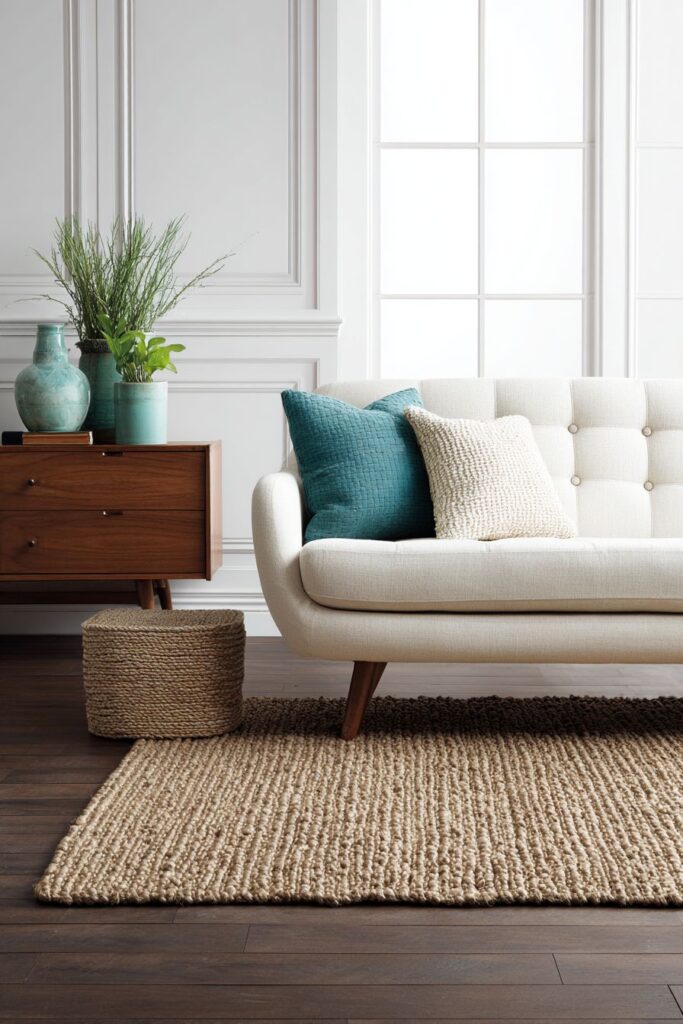
Key Design Tips:
- Build color schemes around warm wood tones with neutral backgrounds and strategic accent colors
- Invest in authentic Danish modern furniture for timeless appeal and superior craftsmanship
- Use button tufting and other subtle details to add visual interest without compromising clean lines
- Select area rugs in natural materials that complement rather than compete with furniture
- Incorporate turquoise accents through accessories that can be easily updated
12. Textural Contrasts and Material Honesty
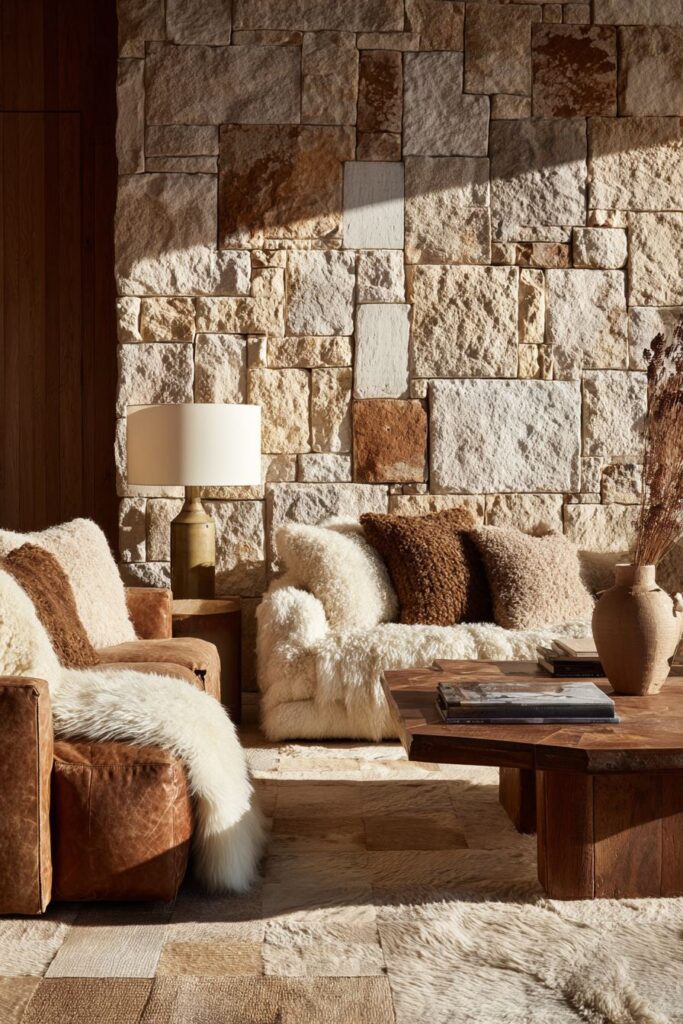
This sophisticated living room celebrates the midcentury fascination with material contrasts, creating a rich sensory environment through the careful juxtaposition of different textures and surfaces. The rough-hewn stone accent wall provides dramatic textural interest while demonstrating the period’s commitment to showing materials in their most honest form, celebrating rather than disguising their natural characteristics. This substantial element creates visual weight and tactile appeal that grounds the entire composition.

The smooth leather seating contrasts beautifully with the stone’s rough texture, its refined surface and subtle patina representing the opposite end of the tactile spectrum while maintaining the natural material origins that connect it to the overall design philosophy. The leather’s ability to develop character through use embodies the midcentury principle that furniture should improve with age rather than deteriorate.
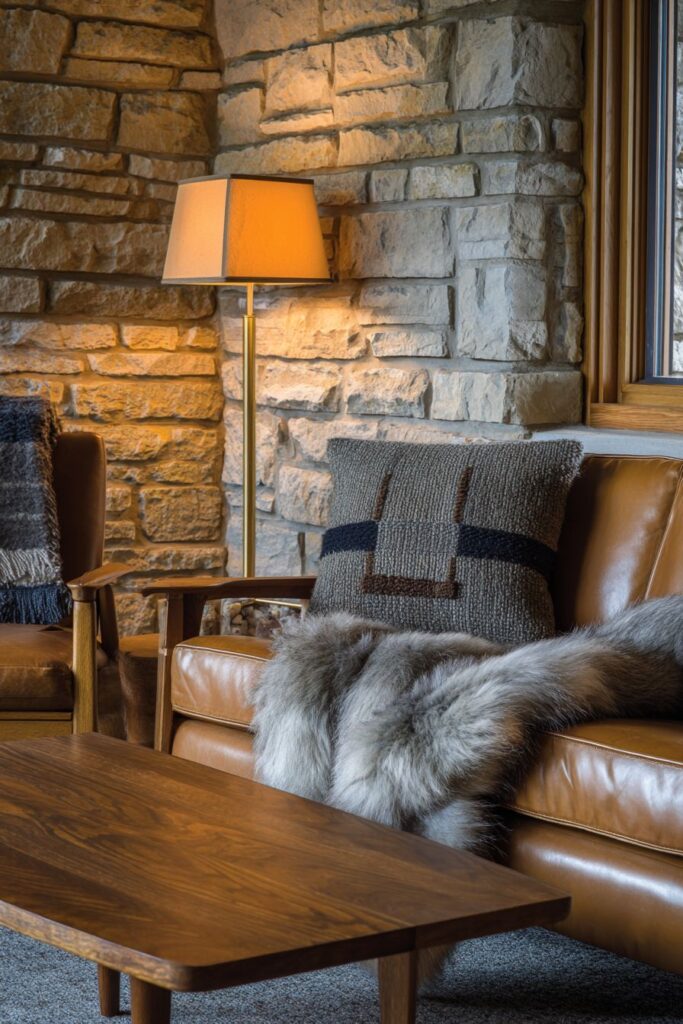
Nubby wool throw blankets add another textural layer while providing practical comfort and visual softness that balances the room’s harder surfaces. These textile elements, with their organic irregularities and warm tactile qualities, demonstrate how accessories can enhance rather than disguise a room’s essential character while adding the personal touches that make a space feel lived-in.
The kidney-shaped coffee table in rich walnut showcases the period’s fascination with organic forms and high-quality craftsmanship, its curved profile and expert joinery creating a sculptural centerpiece that invites touch while serving practical functions. The table’s distinctive shape and beautiful wood grain make it a conversation piece as well as a functional surface.
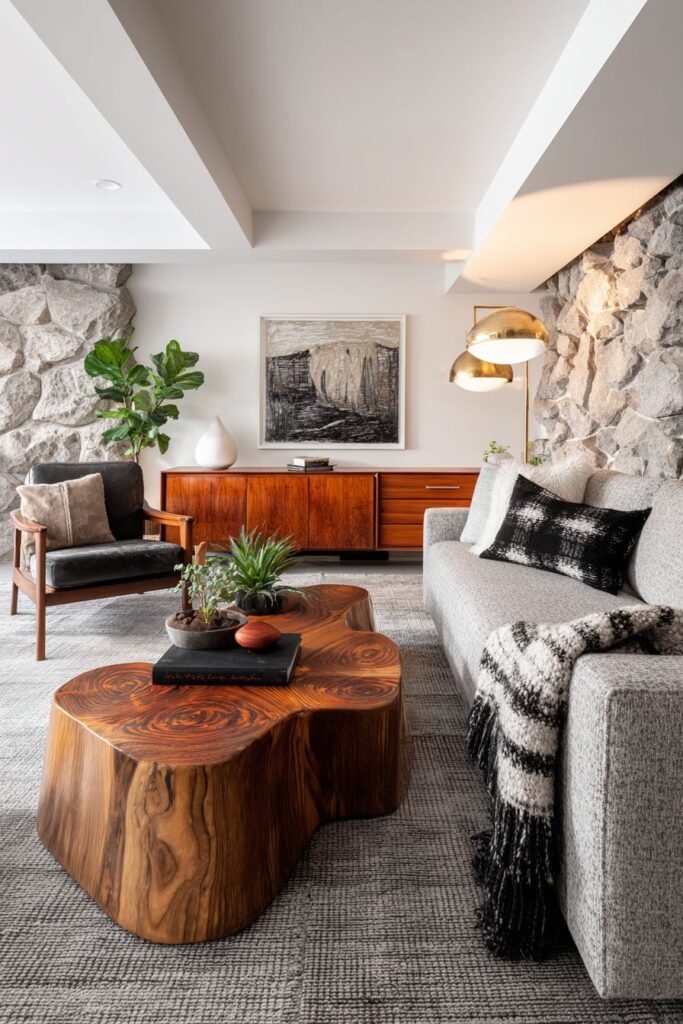
Key Design Tips:
- Combine rough and smooth textures for dynamic sensory contrast
- Use natural materials in their most honest forms rather than disguising their characteristics
- Layer textiles with varied textures to add warmth and visual interest
- Choose furniture with organic shapes to balance geometric architectural elements
- Select coffee tables with distinctive forms that serve as sculptural centerpieces
13. Biophilic Design and Green Integration
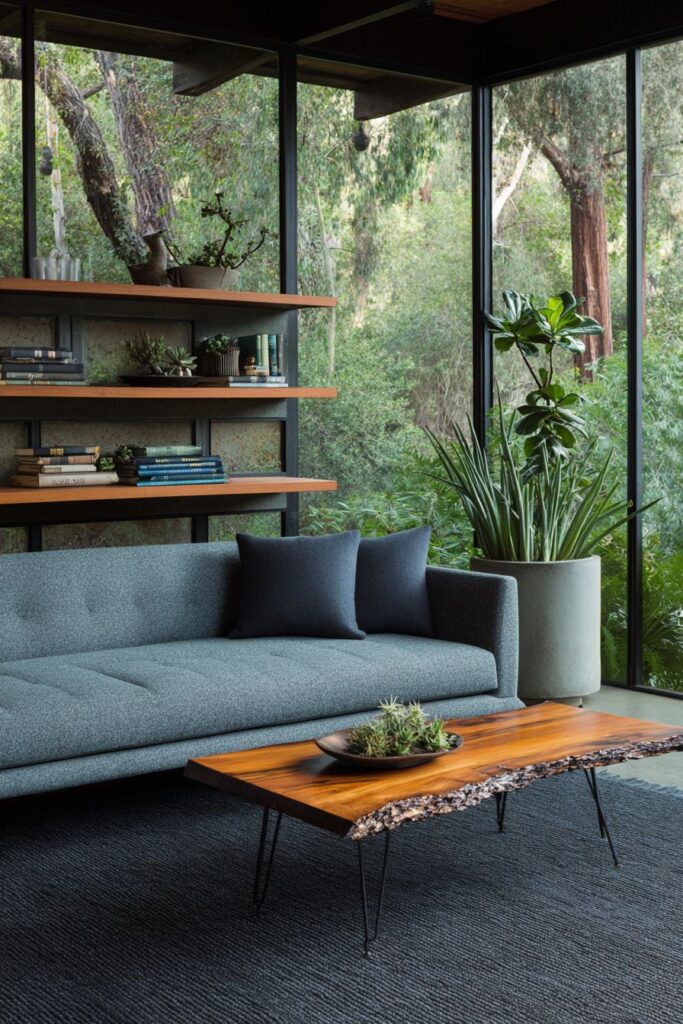
The integration of lush indoor plants transforms this midcentury modern living room into a celebration of biophilic design principles, demonstrating the period’s fundamental commitment to connecting interior spaces with the natural world. The large fiddle leaf fig in its cylindrical planter serves as a living sculpture, its broad leaves and architectural form creating dramatic vertical interest while purifying the air and adding the kind of organic irregularity that keeps spaces from feeling too rigid or controlled.

The careful selection and placement of smaller succulents on floating shelves creates opportunities for ongoing interaction with nature while adding color and textural variety throughout the room. These plants, with their sculptural forms and minimal care requirements, embody the midcentury ideal of bringing nature indoors without compromising the clean lines and uncluttered aesthetic that define the style.
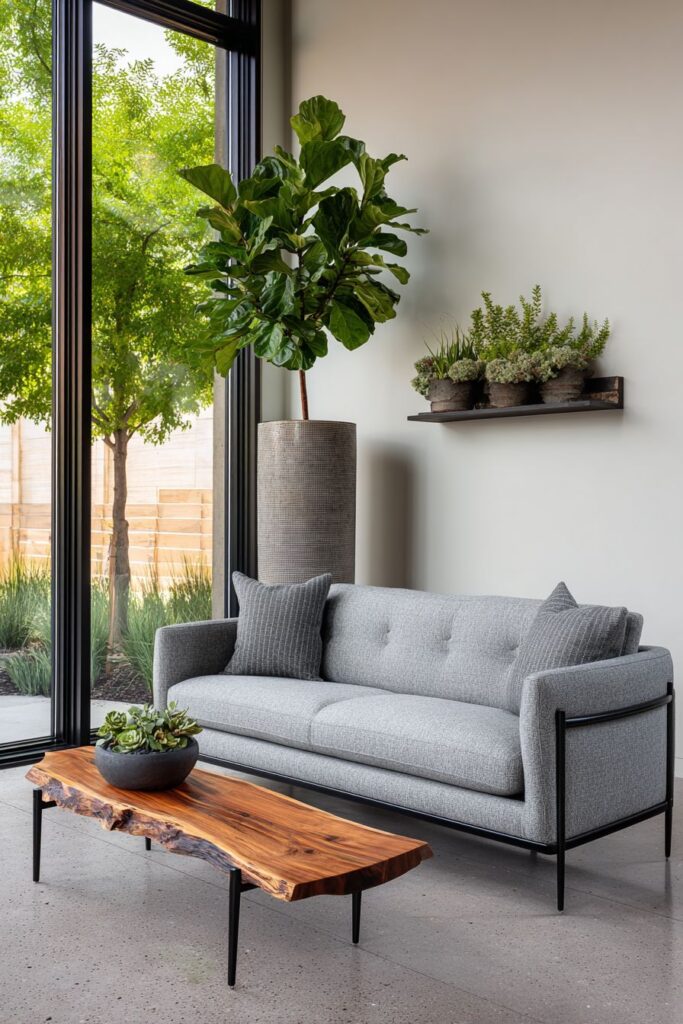
The streamlined sofa with thin metal legs maintains visual lightness that allows the plants to take center stage while providing comfortable seating that doesn’t compete for attention. The sofa’s minimal profile and neutral upholstery create the perfect backdrop for the green elements while maintaining the kind of understated elegance that characterizes the best midcentury furniture design.
The live-edge wooden coffee table celebrates the natural form of the tree from which it was crafted, its organic edge contrasting beautifully with the geometric precision of the surrounding furniture while reinforcing the room’s connection to natural materials and forms. This piece demonstrates the period’s appreciation for honest construction and natural beauty.
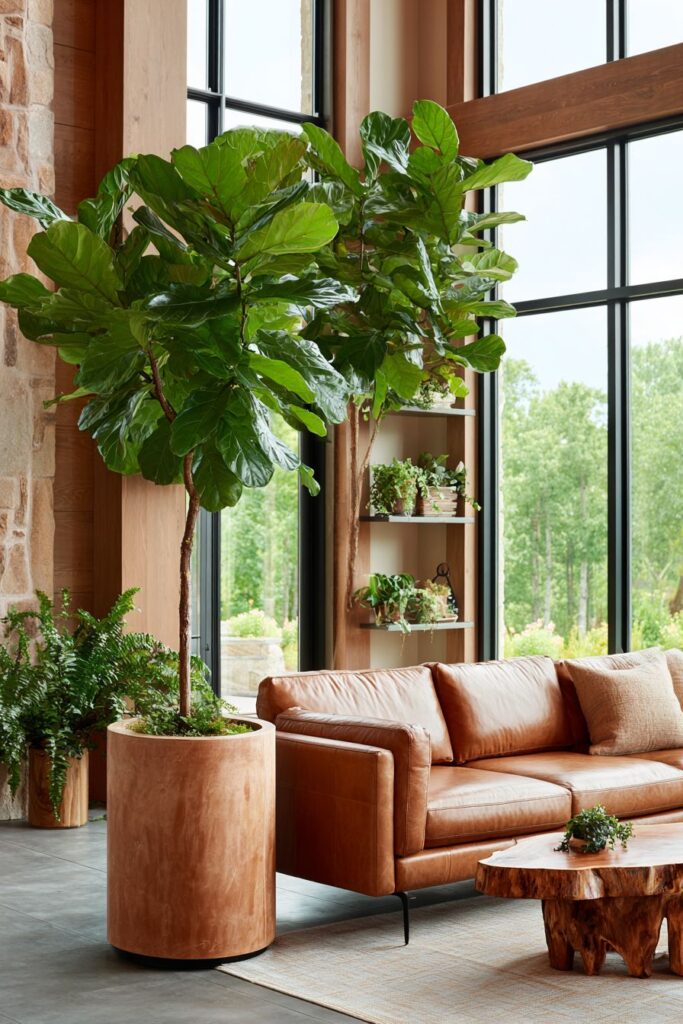
Key Design Tips:
- Use large statement plants as living sculptures and natural air purifiers
- Create plant displays on floating shelves for layered green interest
- Choose furniture with minimal profiles that don’t compete with natural elements
- Select live-edge wood pieces to celebrate natural forms and honest materials
- Position plants near windows to emphasize the indoor-outdoor connection
14. Entertainment Design and Social Flow

This living room configuration prioritizes entertaining and social interaction through thoughtful furniture arrangement and carefully selected pieces that facilitate conversation and gathering. The circular conversation arrangement creates an inclusive environment where all participants can easily engage with one another, embodying the midcentury belief that good design should enhance human relationships and social interaction.

The curved sectional seating wraps around a central round ottoman that doubles as both coffee table and additional seating, demonstrating the period’s genius for multipurpose furniture that adapts to different social situations. This flexible arrangement can accommodate intimate conversations or larger groups while maintaining the visual continuity and flow that makes spaces feel harmonious rather than chaotic.

The vintage bar cart with brass details positioned nearby provides both functional service for entertaining and decorative appeal through its careful styling with period-appropriate glassware and accessories. The cart’s mobility allows it to serve different areas of the room as needed while its brass accents add metallic warmth that complements the room’s other materials.
Pendant lights with cylindrical shades provide intimate ambient lighting that can be adjusted for different moods and activities, their suspended forms adding vertical interest while creating pools of warm light that make evening entertaining feel magical. The lighting’s positioning over the conversation area helps define the social zone while maintaining the room’s overall sense of openness.
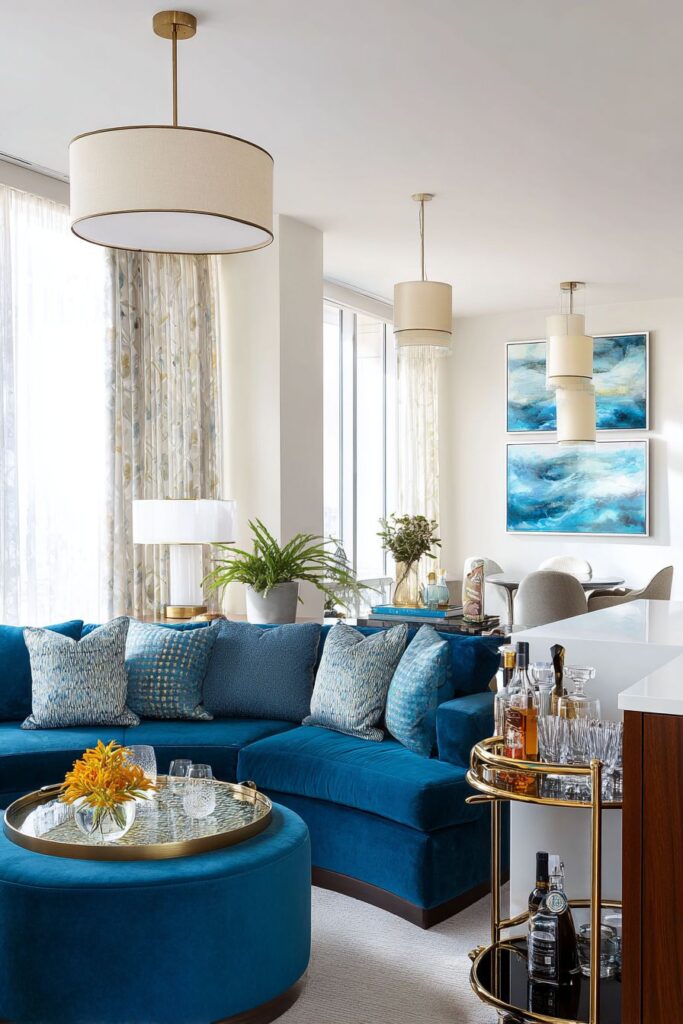
Key Design Tips:
- Arrange seating in circular patterns to facilitate conversation and social interaction
- Use round ottomans that can serve as both seating and table surfaces
- Incorporate mobile bar carts for flexible entertaining solutions
- Install adjustable pendant lighting to create intimate ambiance for evening gatherings
- Choose multipurpose furniture that can adapt to different social situations
15. Reading Retreat and Quiet Contemplation
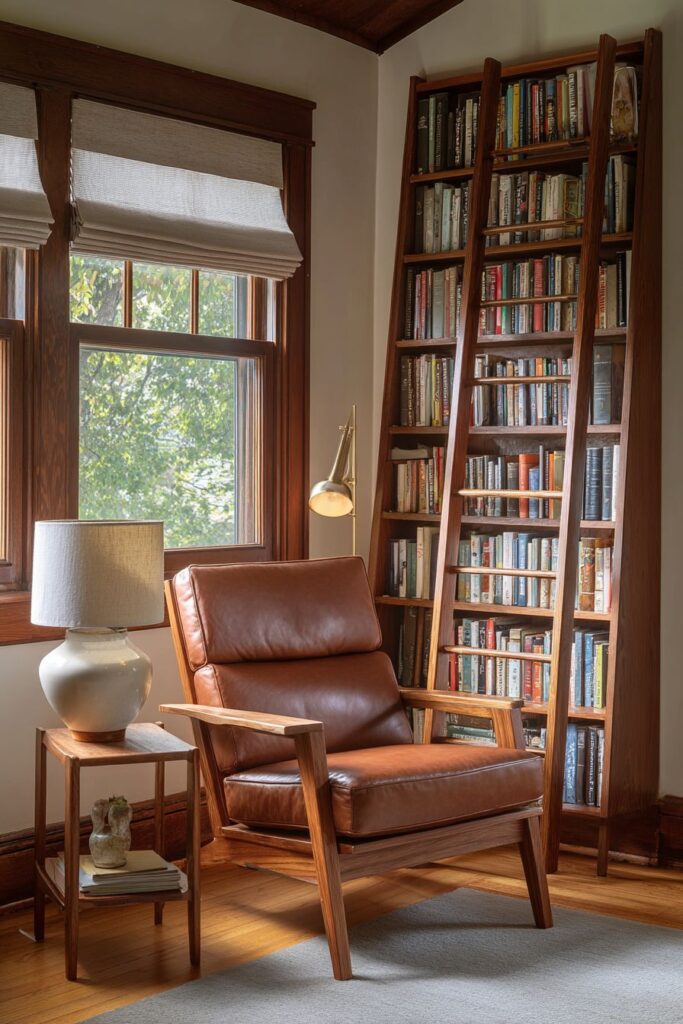
The dedicated reading nook represents the midcentury understanding that homes should provide spaces for various activities and moods, from social entertaining to quiet contemplation. The classic Scandinavian-inspired armchair in teak and leather creates the perfect setting for reading and reflection, its ergonomic design and high-quality materials ensuring comfort during extended periods of use while maintaining the aesthetic integrity that makes it worthy of display even when not in use.

The positioning beside a tall bookshelf with ladder access creates a library-like atmosphere that celebrates the life of the mind while providing practical storage for an extensive book collection. The ladder’s presence adds both functional utility and visual interest, its clean lines and honest construction reflecting the period’s commitment to beautiful utilitarian objects.

The small side table positioned within easy reach holds essential items for reading comfort, from ceramic lamps to books to beverages, demonstrating the thoughtful planning that makes spaces truly functional. The table’s modest scale prevents it from overwhelming the intimate reading area while providing necessary surface space.
Natural light filtering through the nearby window with simple roman shades creates the ideal illumination for reading while connecting the indoor activity to the outdoor environment. The roman shades, with their clean horizontal lines and minimal hardware, provide privacy and light control without compromising the window’s architectural integrity.

Key Design Tips:
- Create dedicated reading areas with comfortable, well-designed seating
- Install floor-to-ceiling bookshelves with ladder access for extensive collections
- Provide adequate side table surface within easy reach of seating
- Position reading areas near windows for optimal natural light
- Use simple window treatments that provide privacy without blocking light
16. Media Integration and Technology Balance

The thoughtful integration of both vintage and contemporary technology demonstrates how midcentury modern principles can successfully accommodate the realities of contemporary living without compromising aesthetic integrity. The low-profile entertainment console in walnut wood provides the perfect scale and material continuity for housing both a vintage turntable and modern flat-screen TV, proving that good design transcends technological generations.
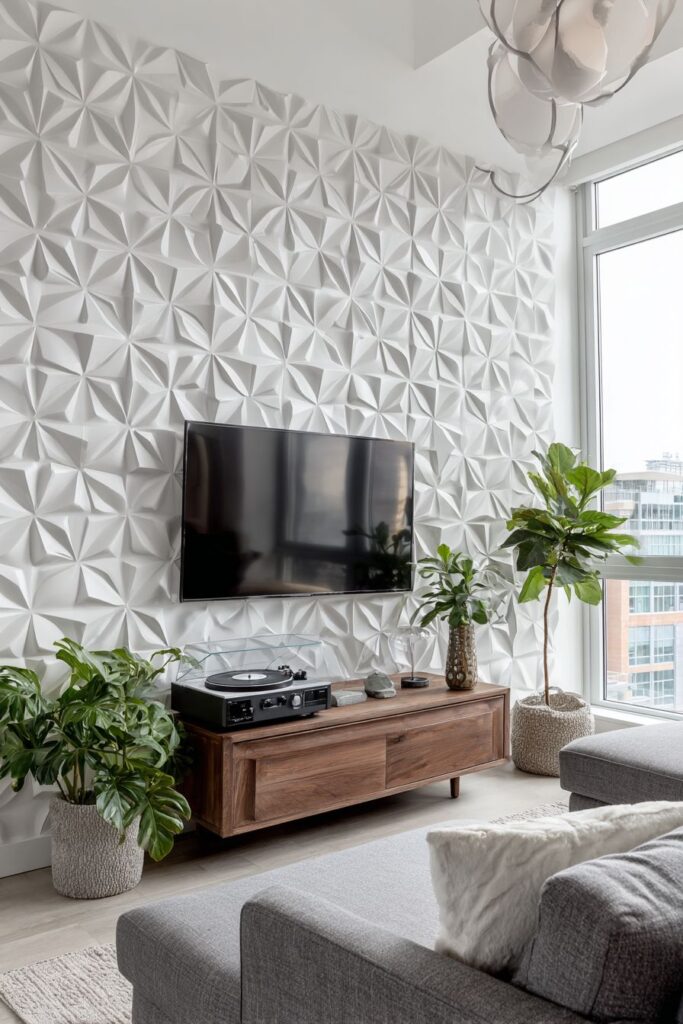
The vintage turntable’s prominent display celebrates the period’s audio equipment as sculpture, its brushed metal surfaces and geometric forms contributing to rather than detracting from the room’s overall aesthetic. This approach transforms functional objects into decorative elements, reflecting the midcentury belief that well-designed products deserved to be seen and celebrated rather than hidden away in cabinets.

The sectional sofa with clean lines faces the entertainment wall, providing comfortable viewing for both music listening and television watching while maintaining the kind of understated elegance that prevents technology from dominating the space. The sofa’s neutral upholstery and minimal ornamentation allow the room’s other elements to take center stage.
Acoustic panels with geometric patterns serve dual functions as both sound treatment and visual art, their systematic arrangement creating wall interest while improving the room’s audio performance. These panels demonstrate how technical requirements can be addressed through design solutions that enhance rather than compromise aesthetic appeal.
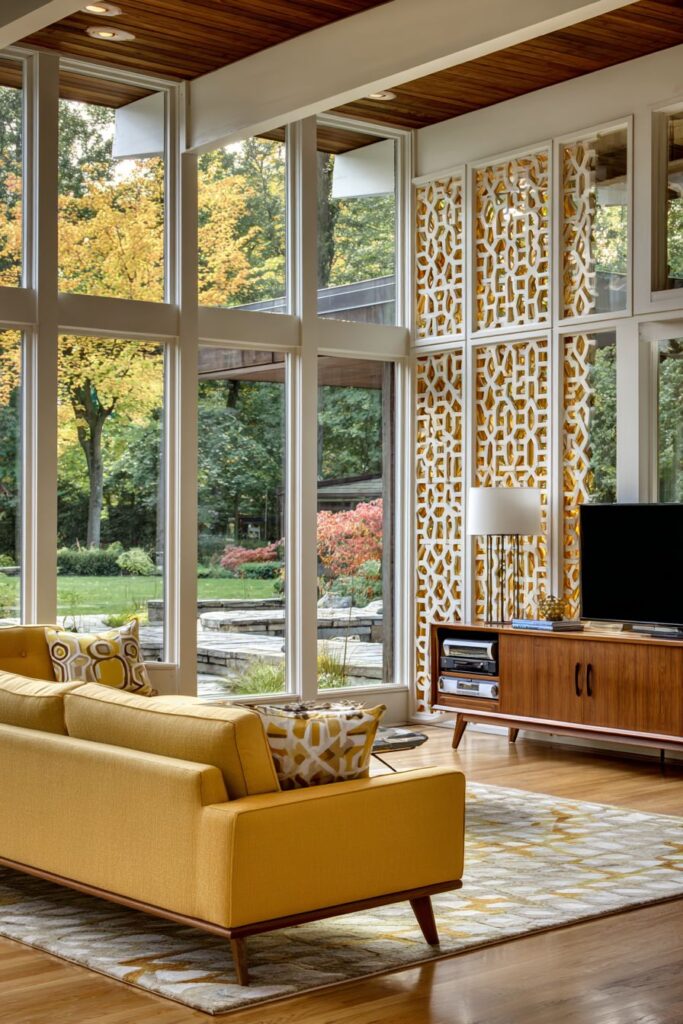
Key Design Tips:
- Choose entertainment consoles that complement existing furniture rather than standing apart
- Display vintage audio equipment as decorative objects worthy of appreciation
- Use acoustic panels with geometric patterns as functional wall art
- Position seating to accommodate both music listening and television viewing
- Integrate technology thoughtfully so it enhances rather than dominates the space
17. Open Floor Plan Definition and Spatial Flow
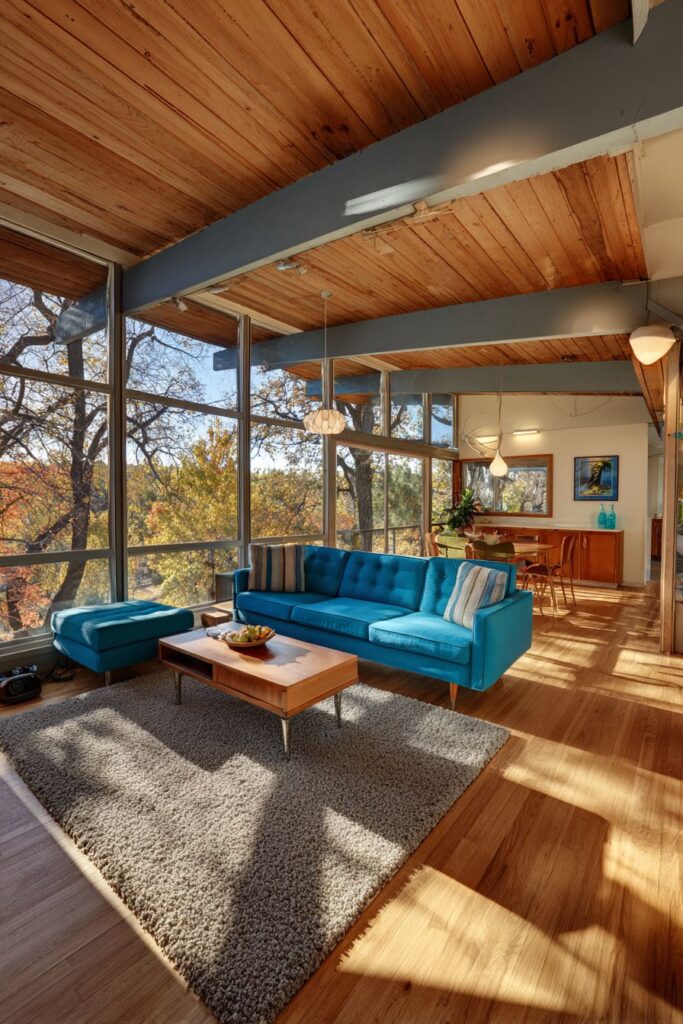
The challenges of open floor plan living require careful furniture placement and spatial definition to create distinct areas while maintaining visual flow and connection between spaces. This living room demonstrates masterful space planning, using furniture arrangement and area rug placement to define the living area while preserving the expansive feeling that makes open plans so appealing.
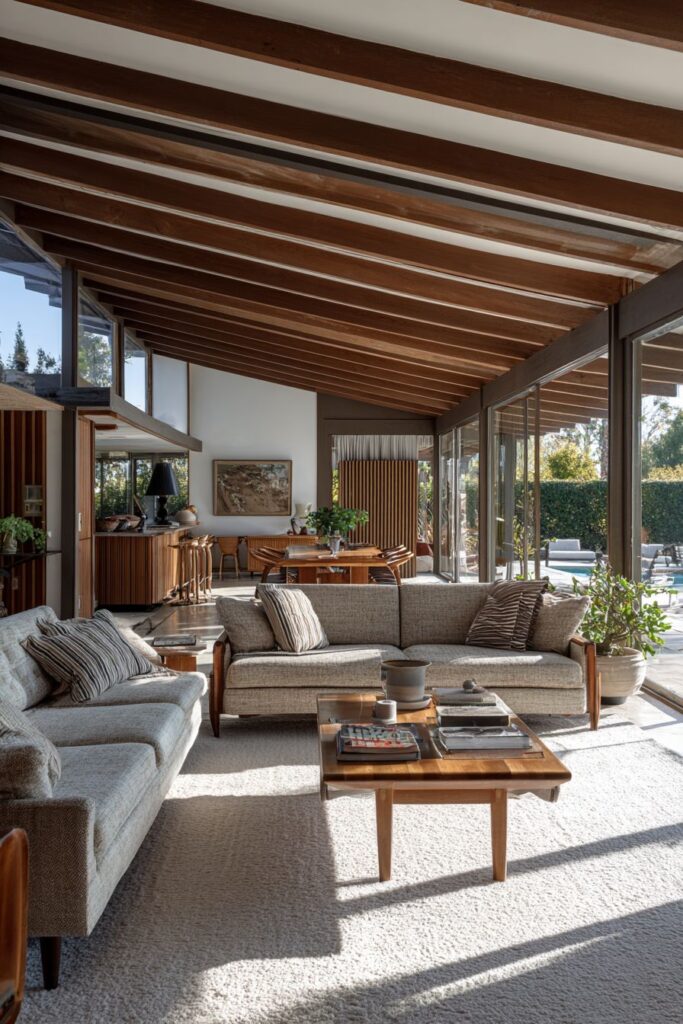
The large area rug serves as the primary tool for defining the conversation area, its generous scale and strategic placement creating a visual foundation that anchors the furniture grouping while distinguishing it from adjacent dining and kitchen areas. The rug’s pattern and color provide the perfect backdrop for the furniture while adding the kind of visual weight that helps define spatial boundaries in open environments.
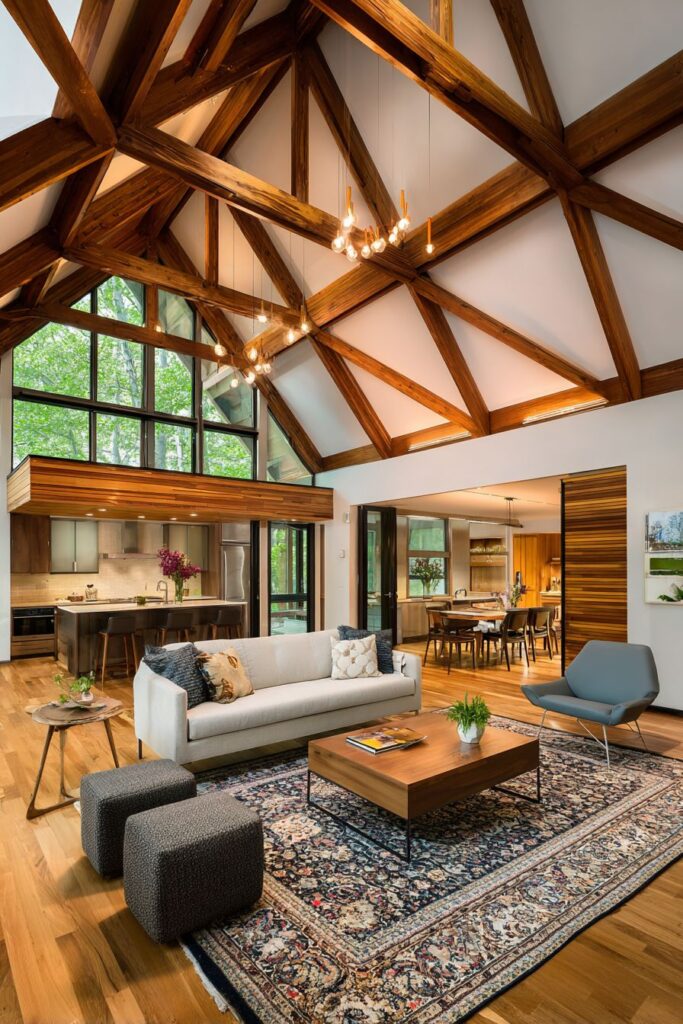
The low coffee table and modular seating arrangement create a functional conversation area that maintains sight lines to other parts of the home while providing comfortable gathering space for family and guests. The furniture’s low profiles and clean lines prevent visual blocking while their strategic positioning creates natural traffic flow around and through the space.
Exposed ceiling joists add architectural character and help define the scale of the open space, their horizontal lines creating visual rhythm while providing the kind of structural honesty that midcentury designers celebrated. These elements add visual weight and definition to spaces that might otherwise feel too expansive or undefined.
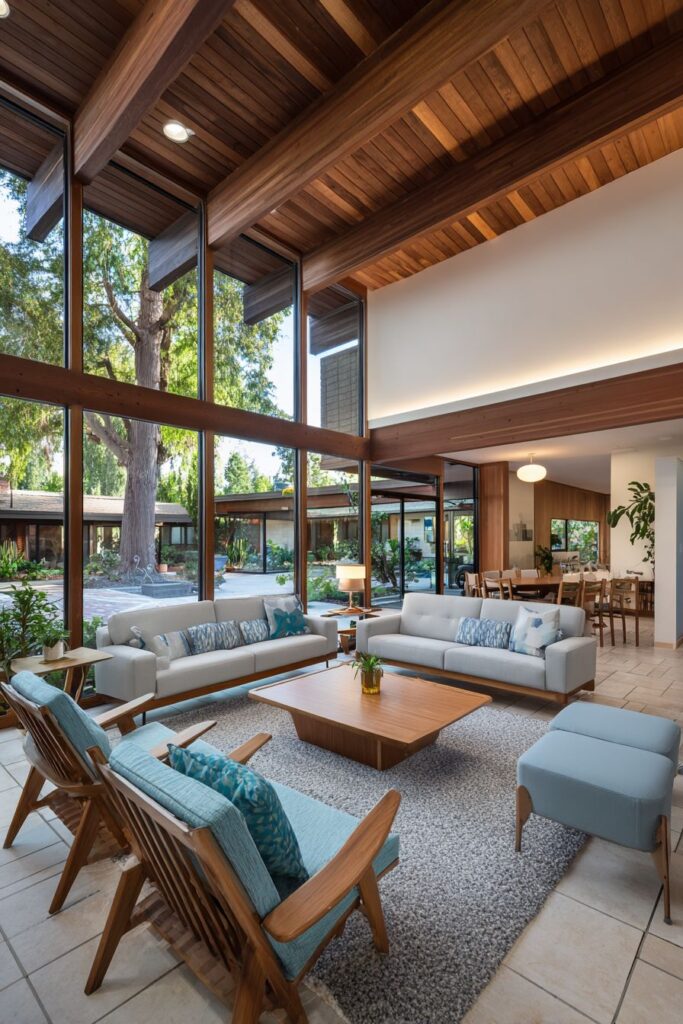
Key Design Tips:
- Use large area rugs to define conversation areas in open floor plans
- Choose low-profile furniture that maintains sight lines between spaces
- Arrange modular seating to create flexible conversation areas
- Incorporate exposed structural elements to add architectural character
- Plan furniture placement to create natural traffic flow through open spaces
18. Iconic Design Elements and Modernist Classics
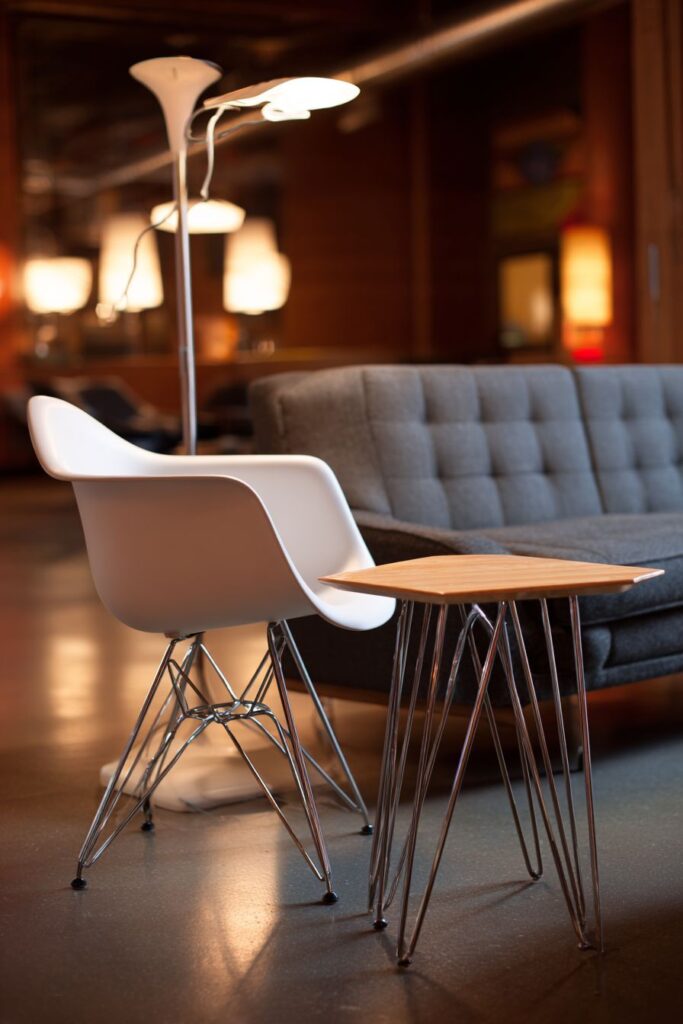
The inclusion of a statement accent chair in the iconic Tulip design immediately establishes the room’s midcentury credentials while providing a stunning example of the period’s most innovative furniture design. The white fiberglass shell and pedestal base represent breakthrough achievements in materials and manufacturing, transforming industrial processes into objects of beauty that remain as striking today as when first introduced.

The chair’s sculptural form and space-age aesthetic provide dramatic contrast to more traditional upholstered pieces, creating visual interest and design tension that keeps the space from becoming too predictable or monotonous. Its distinctive silhouette serves as functional sculpture, equally beautiful whether occupied or empty.
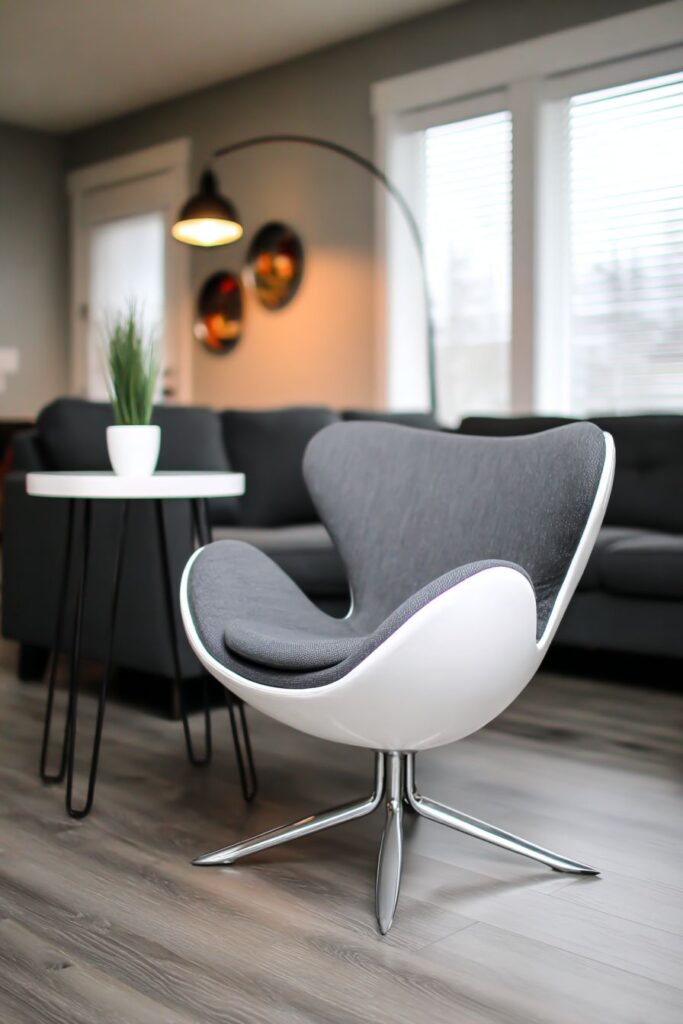
The sleek side table with hairpin legs continues the theme of innovative construction and minimal profiles, its slender metal supports creating the kind of visual lightness that prevents smaller pieces from cluttering the space. The table’s clean lines and honest construction demonstrate the period’s mastery of making utilitarian objects beautiful through thoughtful design.
The main seating consists of a streamlined sofa in charcoal fabric that provides visual grounding for the more dramatic accent pieces while maintaining the kind of understated elegance that allows statement pieces to shine. The sofa’s neutral color and minimal ornamentation create the perfect backdrop for more expressive elements.

Key Design Tips:
- Incorporate iconic furniture pieces as sculptural elements and design statements
- Use accent chairs with distinctive forms to create visual interest and focal points
- Choose side tables with minimal profiles that provide function without visual weight
- Balance dramatic accent pieces with understated main seating
- Select furniture that represents the best of midcentury design innovation
19. Seasonal Styling and Timeless Adaptability

The art of seasonal styling within a midcentury modern framework demonstrates how this timeless aesthetic can adapt to changing seasons while maintaining its essential character and appeal. The warm textile additions, including an alpaca throw blanket draped casually over the sofa arm, add textural richness and seasonal comfort without compromising the room’s clean lines or sophisticated color palette.

The rust-colored throw pillows provide strategic color accents that complement the existing teak wood furniture while introducing the warm, earthy tones associated with autumn. These temporary additions can be easily changed with the seasons, allowing the room to feel fresh and current while preserving the investment in quality furniture and major design elements.

The dried pampas grass in a ceramic vase adds seasonal texture and natural beauty while maintaining the clean aesthetic that defines midcentury modern style. This organic element brings the changing outdoor environment inside while providing the kind of sculptural arrangement that functions as living art.
The successful integration of seasonal elements demonstrates the flexibility and longevity that make midcentury modern design such a wise investment, proving that good design provides a foundation that can accommodate personal taste and seasonal preferences without losing its fundamental appeal.
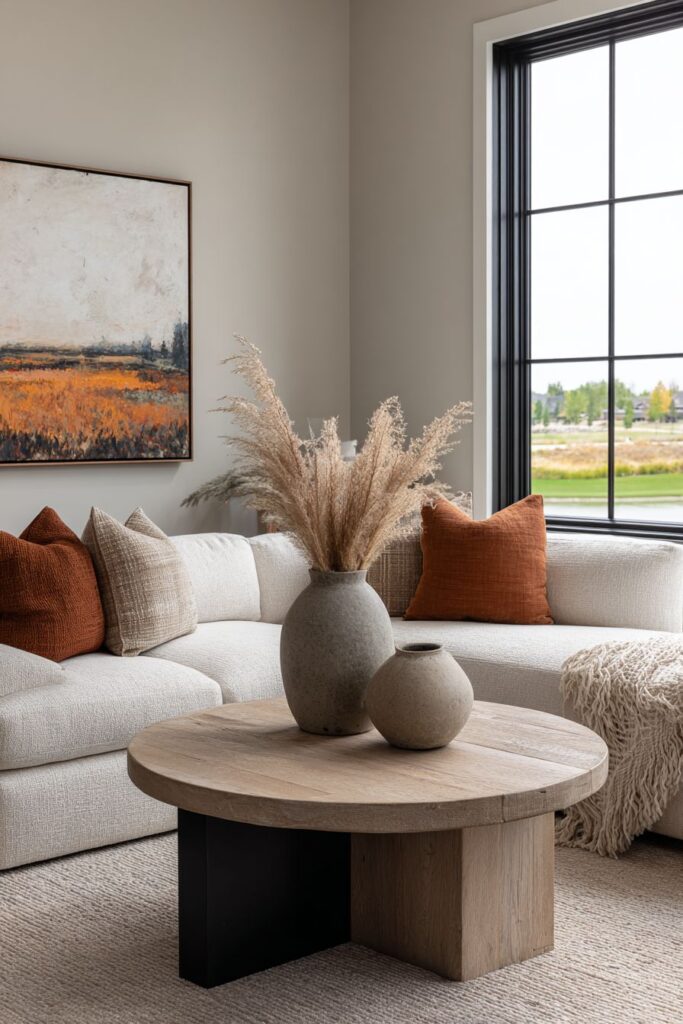
Key Design Tips:
- Add seasonal textiles like throws and pillows for warmth without permanent change
- Choose accent colors that complement existing wood tones and neutral bases
- Use natural seasonal elements like dried grasses for organic texture
- Select ceramic vessels that can transition between different seasonal arrangements
- Maintain the clean aesthetic while adding seasonal warmth and comfort
20. Material Details and Craftsmanship Focus

The intersection of different materials in this detailed composition showcases the meticulous attention to material selection and craftsmanship that elevates midcentury modern design from mere style to lasting art form. The smooth walnut wood grain of the coffee table surface, with its rich color variations and distinctive patterns, demonstrates the period’s celebration of natural materials in their most beautiful form.
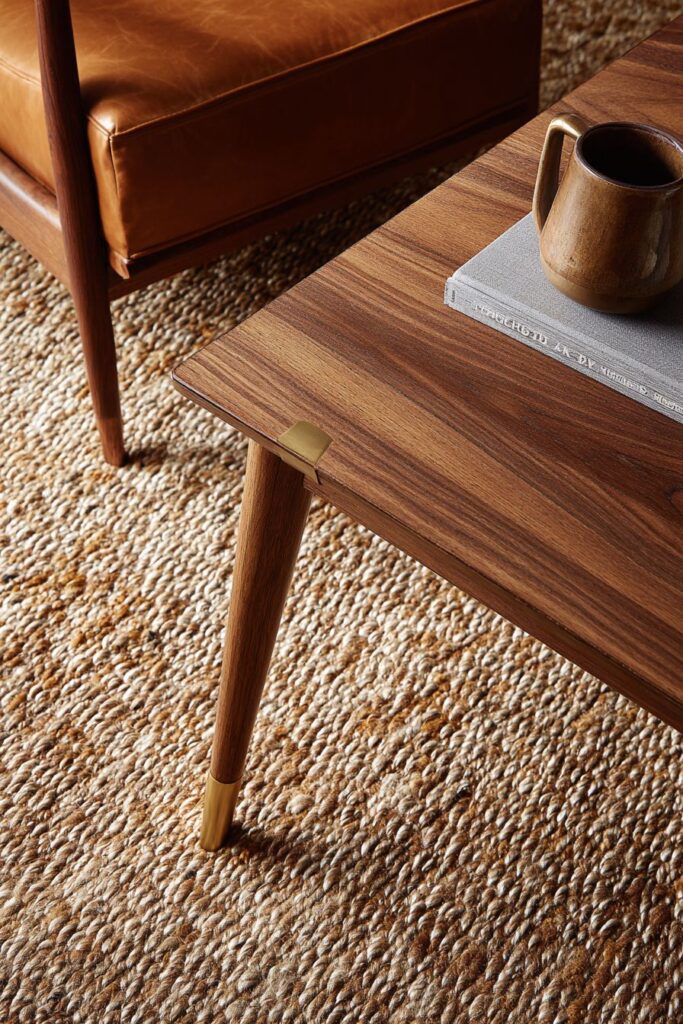
The contrast between the polished wood surface and the nubby texture of the wool area rug creates the kind of sensory richness that makes spaces feel luxurious and inviting. This juxtaposition of smooth and textured surfaces provides visual and tactile interest while demonstrating the sophisticated material palette that characterizes the best midcentury interiors.

The glimpses of leather upholstery and brass hardware details add additional material notes to the composition, their warm tones and honest surfaces contributing to the overall harmony while providing the kind of detail that rewards close inspection. These elements demonstrate the period’s commitment to using the finest materials and hardware available.
The careful attention to material selection and craftsmanship quality represents the midcentury belief that good design should be both beautiful and enduring, creating objects and spaces that improve with age rather than deteriorate. This philosophy of investment in quality over quantity continues to influence contemporary design thinking.
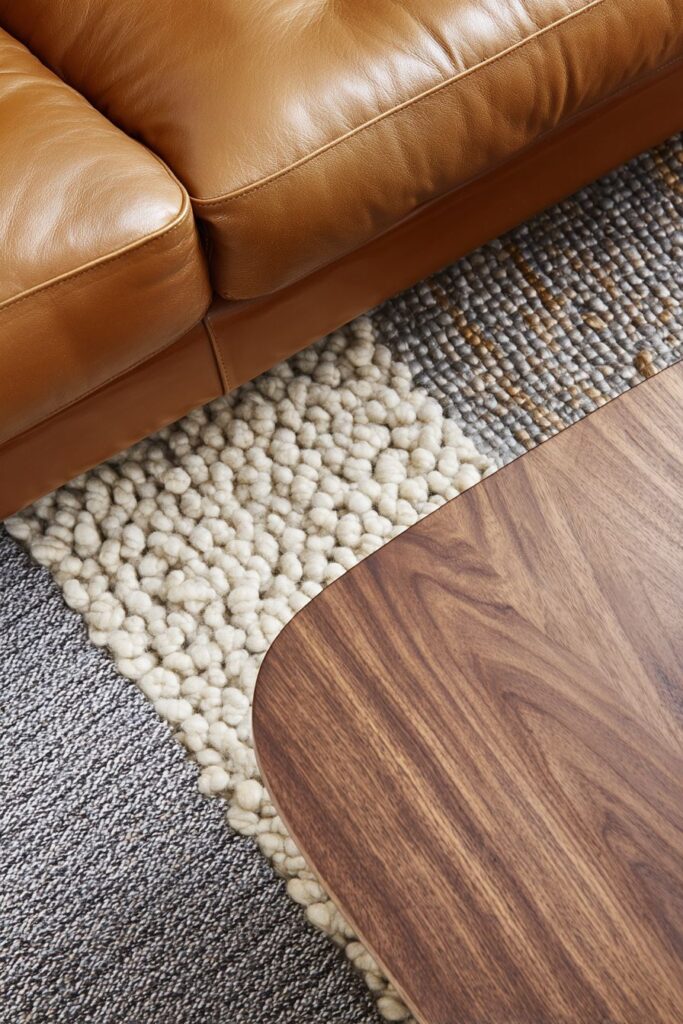
Key Design Tips:
- Focus on material quality and natural beauty over superficial decoration
- Create sensory richness through the contrast of different textures and surfaces
- Select hardware and details that complement rather than compete with main materials
- Invest in craftsmanship quality that will improve with age and use
- Pay attention to material intersections and how different elements work together
Conclusion
The twenty design concepts explored in this comprehensive guide demonstrate the incredible versatility and enduring appeal of midcentury modern style, proving that this influential movement offers solutions for every type of living space and lifestyle preference. From intimate reading nooks that celebrate quiet contemplation to expansive entertainment areas designed for social gathering, midcentury modern principles adapt beautifully to contemporary needs while maintaining their essential character and timeless sophistication.
The consistent themes that emerge throughout these diverse approaches—material honesty, clean lines, connection to nature, and thoughtful integration of function and beauty—provide a framework for creating living spaces that feel both current and timeless. Whether you’re drawn to the dramatic impact of statement lighting, the warm appeal of natural wood finishes, or the sophisticated color palettes that define the era, these design concepts offer inspiration and practical guidance for creating your own midcentury modern sanctuary.
The beauty of midcentury modern design lies not just in its aesthetic appeal, but in its fundamental philosophy of creating environments that enhance daily life through thoughtful design, quality materials, and honest construction. As you consider implementing these ideas in your own home, remember that the best midcentury modern spaces feel both designed and lived-in, sophisticated and comfortable, timeless and personal. Start with quality foundational pieces, layer in textural elements and carefully chosen accessories, and allow your space to evolve naturally while maintaining the clean lines and material honesty that make this style so enduringly appealing.
